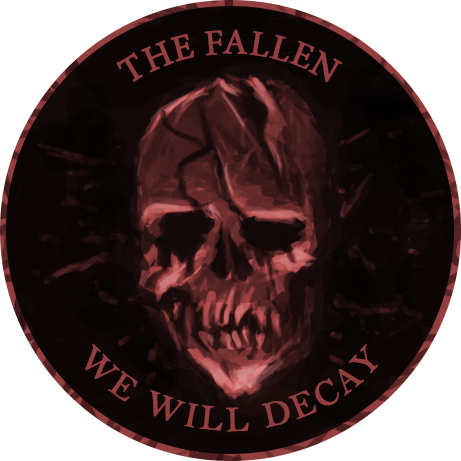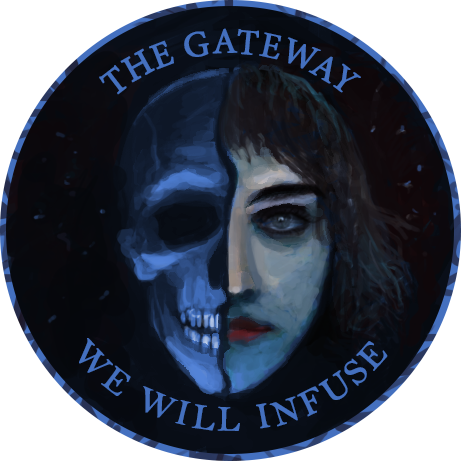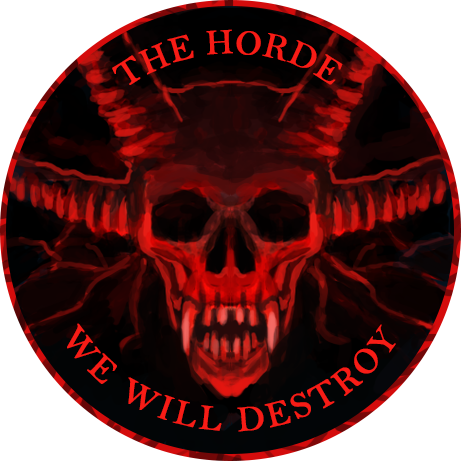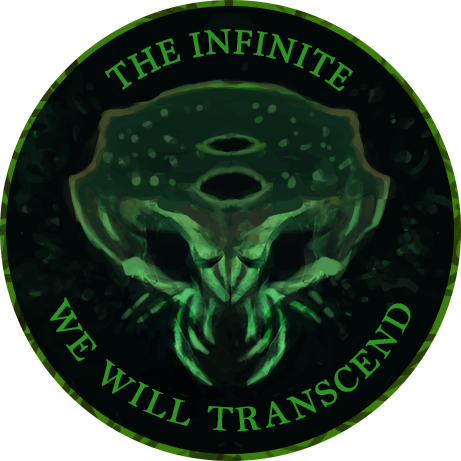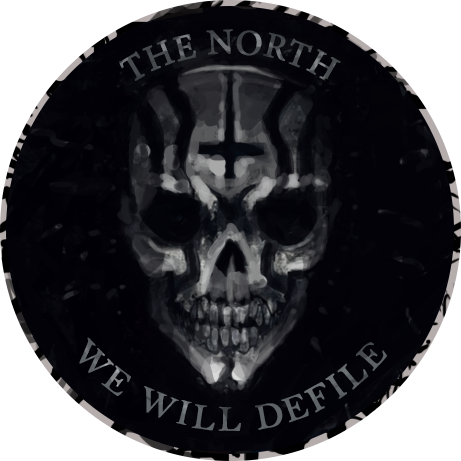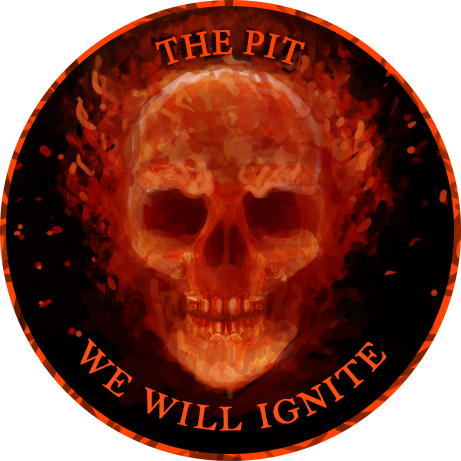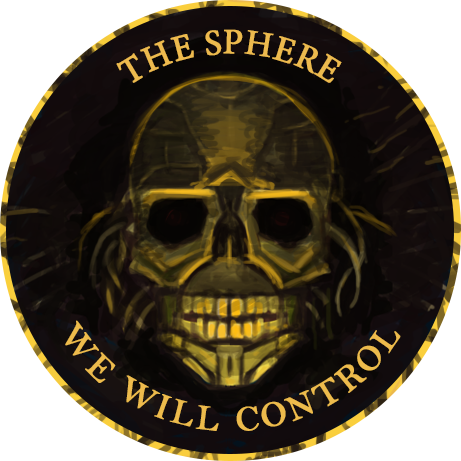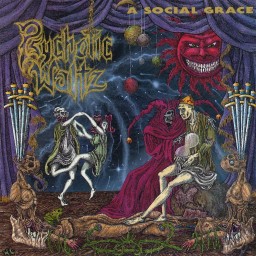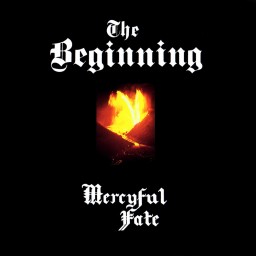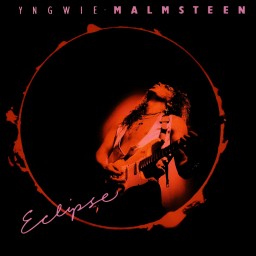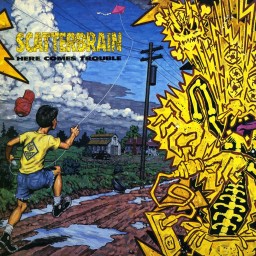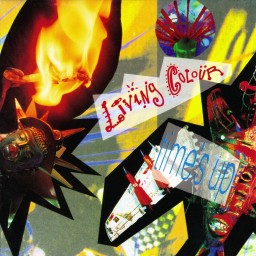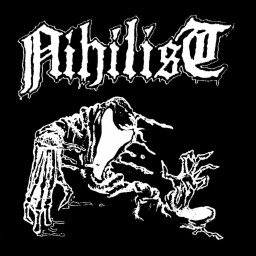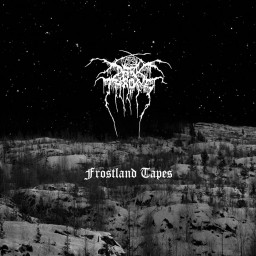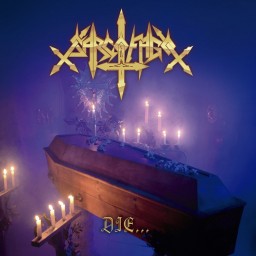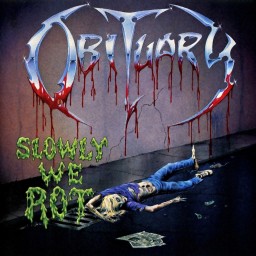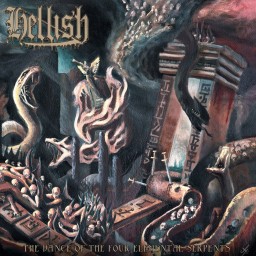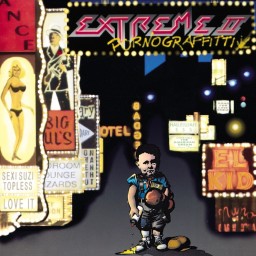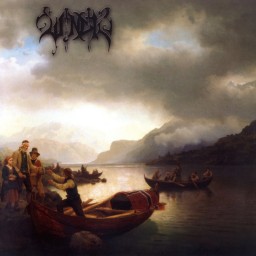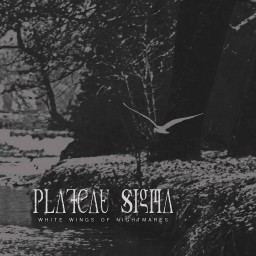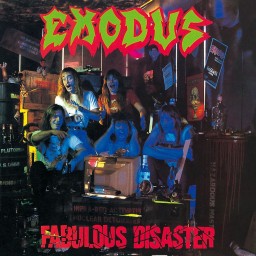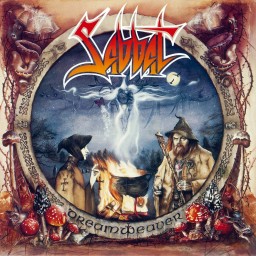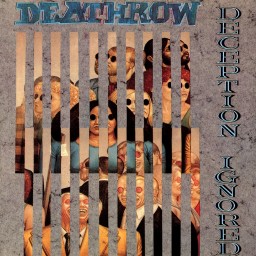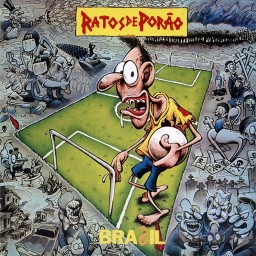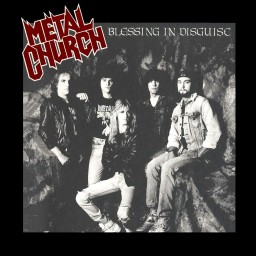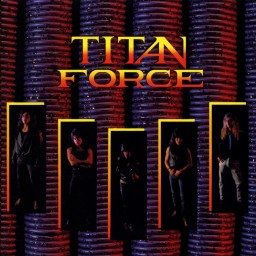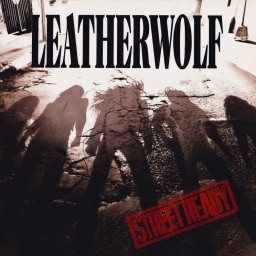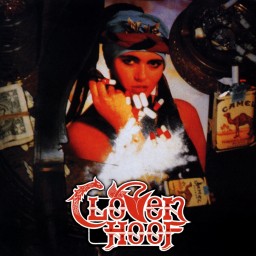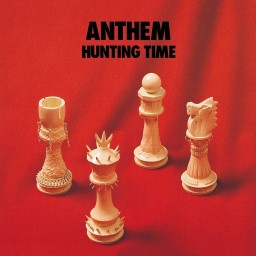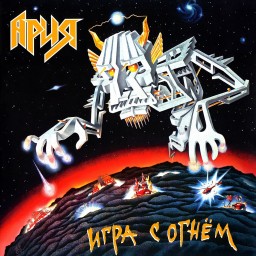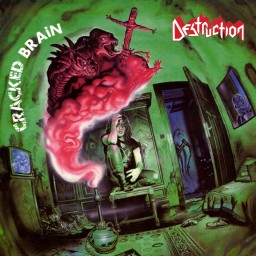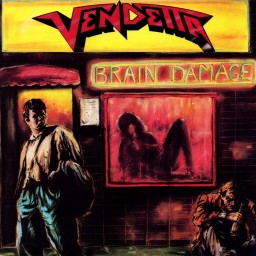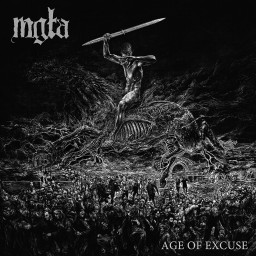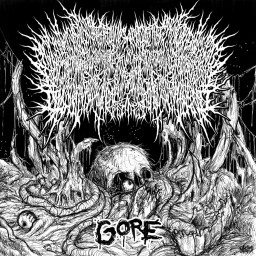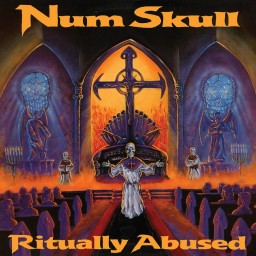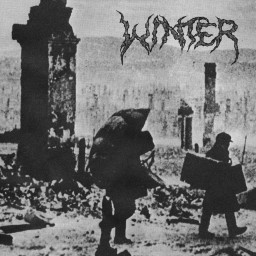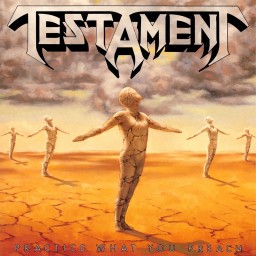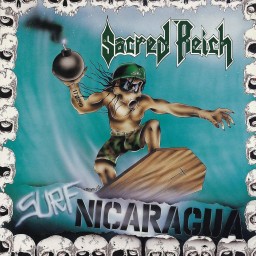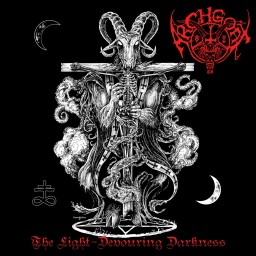Daniel's Reviews
How I’ve managed to overlook San Diego progressive metallers Psychotic Waltz up until now is anyone’s guess because their 1990 debut album is a very impressive effort to say the least. “A Social Grace” harnesses outstanding musicianship & some highly complex arrangements to create over an hour of seriously classy metal music that lacks nothing in the heaviness department either. Fans of 1980’s Fates Warning should immediately get onboard this ship as there are close similarities however I’d suggest that Psychotic Waltz are a touch heavier with their sound further indulging in the chunkier end of the US power metal scene more consistently.
Front man Buddy Lackey takes a theatrical & operatic approach that often sounds quite a bit like Iron Maiden/Samson legend Bruce Dickinson. He does a pretty reasonable job at navigating Psychotic Waltz’s rhythmic technicalities & ensures that none of the thirteen tracks included could be considered as weak or filler. There’s a noticeable lack of memorable vocal hooks though & it’s this absence that sees the appeal of “A Social Grace’ being capped at around that four-star mark. The instrumentation is often nothing short of dazzling but I can’t say that I can remember much of the song-writing afterwards & that can be the difference between good & great when it comes to progressive music a lot of the time as it clearly is here.
Still… you’ll do well to find a more capable & professional example of early progressive metal than this one. It’s right up there with the best material that had been released to the time in my opinion & I’d probably take it over Fates Warning’s more well known classics like “The Spectre Within” or “Awaken The Guardian” to be honest.
Genres: Progressive Metal
Format: Album
Year: 1990
I know I'll likely be in the extreme minority here when I tell you that the first release I purchased from legendary Danish heavy metal icons Mercyful Fate was this 1987 compilation back in the early 1990's. It brings together the band's very strong 1982 self-titled debut E.P. with three alternative versions of tracks taken from their 1983 "Melissa" album that were recorded for the BBC's "The Friday Rock Show" & the B-side from the "Black Funeral" single. It also succeeds in its intent due to the very high quality of everything the band attempt.
I've always rated the self-titled E.P. very highly. In fact, I place it a cut above Mercyful Fate's widely celebrated sophomore album "Don't Break The Oath" these days which is saying something. "Melissa" is my favourite Fate record too so I really couldn't go wrong with this material. The BBC recordings are well produced with the versions of "Curse Of The Pharaoh" & "Satan's Fall" being particularly strong. The B-side "Black Masses" suffers a little in the production department but still possesses that classic Mercyful Fate aura which gives it enough appeal to make it interesting too. The highlight is undoubtedly "A Corpse Without Soul" from the E.P. though as it's one of the great heavy metal anthems from the early 80's.
All of the qualities you look for in a Mercyful Fate record are here in spades. The soaring vocals, the dark atmosphere, the searing solos... You can't really go wrong with "The Beginning" & it should be regarded as essential listening if you're a devotee of those first couple of Fate releases.
Genres: Heavy Metal
Format: Compilation
Year: 1987
I’ve been very much looking forward to investigating some more of Tokyo heavy metal four-piece Anthem’s more widely celebrated releases after thoroughly enjoying my initial experiences with their highly regarded 1989 fifth album “Hunting Time” recently so I decided to give their 1987 third full-length “Bound To Break” a crack this week. It features a slightly different lineup with Eizo Sakamoto handling the microphone duties before Yukio Morikawa had entered the fold & Sakamoto proves himself to be a talented & powerful singer with his masculine tone being a highlight of the record. As with “Hunting Time”, English producer Chris Tsangarides has produced a particularly metal sounding album here too. It feels a lot like Judas Priest’s “Defenders of the Faith” in that way. The quality of the song-writing isn’t quite as strong as “Hunting Time” though with most of the tracklisting sitting a step down from the best material on that record, despite the fact that there are no weak tracks to speak of. The best moments appear during the one-two punch of faster power metal number “Empty Eyes” & chunky heavy metal anthem “Show Must Go On!” while the progressive electronic interlude “Limited Lights” is also a welcome addition.
Anthem were clearly a force to be reckoned with back in the 1980’s & are probably the best Japanese heavy metal band I’ve heard to date but “Bound To Break” doesn’t feel as essential as “Hunting Time”. It’s not that different in its approach but it doesn’t deliver the knockout blows through powerful chorus hooks as regularly which leaves it sitting as a nice-to-have rather than a buy-or-die.
Genres: Heavy Metal
Format: Album
Year: 1987
My knowledge of Chicago doom legends Trouble was limited to their first couple of classic mid-1980’s albums until I decided to investigate their highly regarded self-titled fourth album this week. I’m a big fan of Trouble's 1984 debut album “Psalm 9” while it’s follow-up from the following year “The Skull” was worth a few listens too. Interestingly though, “Trouble” seems to be regarded as more of a heavy metal release than a complete doomathon though which intrigued me. It’s often referred to as one of Trouble’s very best releases too so I was keen to see what it had to offer.
After giving “Trouble” a few spins over the last couple of days, I’ve found it to be another very well produced & executed metal album from a band that really knows their stuff. It’s benefited from a nice, heavy sound with a crisp clarity & some solid performances. Front man Eric Wagner in particular delivers one of his best contributions. Unfortunately though, there were some unexpected challenges to be found for me in the stylistic direction of this album. You see, while it may not be something that’s been widely spoken about, “Trouble” is actually just as much of a stoner metal record as it is a heavy metal one, perhaps even more so. None of the ten tracks can accurately be described as doom metal, instead offering a groovy brand of down-tuned riffage that’s very similar to that which English doom merchants Cathedral would start to push a few years later, only with some added heavy metal chug thrown in to the mix. Now, I’ve never been much of a fan of your groovier stoner metal model. In fact, it kinda urks me if I'm being completely honest so I’ve struggled with most of “Trouble”. Only the more heavy metal inclined tracks like “The Wolf” & “E.N.D.” have managed to offer me much in the way of appeal along with the Beatles-inspired hard rocker “The Misery Shows (Act II)” so I can’t say that this has been a particularly rewarding experience overall. Perhaps it’s just a case of a record like this one simply not being any of my business. I think I’ll stick to Trouble’s doomier releases in future.
Genres: Heavy Metal
Format: Album
Year: 1990
The Washington progressive metal kings' fourth full-length is the first & only one of their records that I bought immediately upon release, fresh off the back of being blown away by the title track on underground metal radio. It's a beautifully produced record too with stunning performances from all of the contributors, particularly super-talented front man Geoff Tate. What I wasn't quite prepared for was the more commercially accessible sound that the band had opted for on this occasion though & it took a bit of adjusting to. You see, "Empire" isn't technically a metal record as it only contains a couple of metal tunes which also happen to be the highlights of the album (see "Empire" & "One & Only"). The rest of the record sits very much in the progressive rock & hard rock space, sounding kinda like a more complex version of "Hysteria"-period Def Leppard more than anything else. Now, that's not a problem in itself & there is no doubt some of Queensrÿche's best material to be found here in patches but there are some clear inconsistencies in the quality of the song-writing that I find to be an issue. The wins (like the wonderfully seep & stripped-back prog rocker "Della Brown") certainly outweigh the losses & make "Empire" worth exploring but radio-friendly tracks like "Jet City Woman", "Another Rainy Night (Without You)" & "Resistance" & "Hand on Heart" go a long way to convincing me that this was the least impressive Queensrÿche release to the time.
Genres: Heavy Metal Progressive Metal
Format: Album
Year: 1990
The first Yngwie record that I would buy upon release also happened to be his weakest to the time. I don't recall having too much of a problem with it back in the day but in more recent times I'm finding myself struggling a bit. He's returned with an entirely new band (most notably missing the Johansson brothers) which has taken the more commercially accessible sound of "Odyssey" a little further for most of the album while attempting to balance it out with a few faster & more aggressive power metal numbers. It's the stuff that sits in between in the traditional heavy metal space that I really dig (see "Making Love", "Devil in Disguise", "What Do You Want", "Faultline") but I find the rest of the album to be pretty patchy, particularly the AOR/glam metal number "Save Our Love" which is nothing short of an atrocity. New frontman Goran Edman does a pretty reasonable job while keyboardist Mats Olausson struggles to compete with his well-known predecessor. The quality of the song-writing is noticeably weaker than on "Odyssey" with even the neoclassical metal instrumental title track falling short of the mark. "Eclipse" marks the first blemish on the guitarists resume for mine.
Genres: Heavy Metal Neoclassical Metal
Format: Album
Year: 1990
One of my best mates at high school picked up the debut album from New York's Scatterbrain very shortly after it was released off the back of the super-popular novelty single "Don't Call Me Dude" which resulted in me receiving a dubbed copy. Even though there's a clear tongue-in-cheek attitude behind the album, I quite enjoyed it too & a lot of that has to do with the high-quality musicianship & the general thrashiness of the material. Despite "Here Comes Trouble" generally being tagged as a funk metal record, that's a misleading guide as to what you'll ultimately hear with only a couple of tracks sitting in genuine funk metal territory. The remainder is very much a hybrid of alternative metal & some really well executed thrash metal that clearly showcases the band members roots in crossover band Ludichrist. I'd describe the album as a combination of the funk/alternative metal of Faith No More, the classy thrash metal of Megadeth & the snot-faced crossover thrash fun of Suicidal Tendencies.
The opening titled track is a 90's thrash classic in my opinion while songs like "I'm With Stupid", "Down With The Ship (Slight Return)", "Mr. Johnson and The Juice Crew" & the much-talked-about "Don't Call Me Dude" are all really solid too. There are a couple of stupid inclusions like neoclassical metal instrumental "Sonata #3" & comedy/novelty rock closer "Drunken Milkman" that bring things back a bit & the funkier tracks aren't as appealing to me personally but this is still a surprisingly decent metal record & I seem to remember every second of it too.
Genres: Alternative Metal
Format: Album
Year: 1990
Coming off the back of revisiting the 1988 debut album "Vivid" from this New York outfit recently, I thought I might give the same privilege to Living Colour's sophomore album too. I picked up a dubbed cassette copy from someone at school at the time of release & remember quite liking it, mainly due to Vernon Reid's fusion-inspired lead guitar work which seriously shreds. It's certainly a more serious record than "Vivid" was. It's also a much more metal one too. I've always struggled to see why people like to label "Vivid" as a metal release to be honest. To my ears it was more of a hard/funk rock album but "Time's Up" is one of the rare records that I actually feel is worthy of the funk metal tag as I find most of the others to receive that tag either don't include the funk element consistently enough or aren't really metal. The musicianship is astoundingly good from all parties but, while there's undoubtedly some strong material here, I don't think there are any genuine classics included. The calypso single "Solace of You" doesn't do anything for me & neither do any of the short interludes, all of which could have been comfortably omitted. Overall, I'd suggest that it's a better record than "Vivid" & I still quite like it but I wouldn't say that it's essential.
Genres: Alternative Metal
Format: Album
Year: 1990
When I first started tape trading back in the very early 1990’s, I remember being somewhat dazzled by the rare demos & live sets that so many of my trading partners had gotten their hands on. I was completely infatuated with the scene & the proper releases that it contained at the time but the idea of discovering hidden gems that only a select few had experienced was enough to see me gorging myself on demo tapes from so many of the great extreme metal bands of the day. You’ve probably seen me revisiting a few of these over the last couple of weeks but one of the more consistent ones comes from Swedish death metal legend Entombed (or Nihilist as they were known in their early days). I vividly remember getting enjoyment out of all four of their demo tapes so the idea of a modern-day reassessment has seemed quite attractive for a while now, particularly given that there’s a compilation that not only draws them all together with superior sound quality but also includes a few unreleased tracks.
The ”1987-1989” compilation (or “Carnal Leftovers” as it’s more recently been retitled) contains fourteen tracks from the period specified & showcases the development of not only the classic Entombed sound but also the Swedish death metal sound in general with each successive release seeing them getting closer & closer to the filthy wall of noise they’d blow the metal world away with via 1990’s “Left Hand Path” debut album. It takes a chronological approach to its programming with Nihilist’s earliest demo tape “Premature Autopsy” from March 1988 kicking proceedings off. “Premature Autopsy” showcases a band that was still clearly searching for their sound with obvious thrash metal & hardcore punk influences infiltrating the death metal we’d come to expect from Entombed. Vocalist LG Petrov (who had been borrowed from his regular position as the drummer in fellow Swedish death/black metal outfit Morbid for the recording sessions along with band mate & guitarist Ulf Cederland) hadn’t quite developed a true death growl yet, instead sounding similar to a Teutonic thrash front man. Opener “Sentenced To Death” is very much a death/thrash hybrid too with a foot in both the early Death & the Slayer/Dark Angel/Kreator camps. “Supposed To Rot” is much more in line with the sound we associate with Entombed & is pure Swedish death metal while the title track is more like thrashy hardcore than it is death metal & is one of the weaker inclusions on the compilation overall. “Premature Autopsy” was certainly the least impressive of the four demos but I still quite like it nonetheless.
Nihilist second demo “Only Shreds Remain” was released early the following year & would bring with it some lineup changes. Petrov had now joined the band on a permanent basis while bassist Leffe Cuzner had switched to guitar which had allowed future Unleashed front man Johnny Hedlund to enter the fold. The sessions were also conducted at the now legendary Sunlight Studios which has become synonymous with the Swedish death metal sound & the result is a slightly more consistent three-song effort that now sits firmly in the death metal camp. Petrov’s vocals are now deeper & more deathly although there has always been some speculation as to whether these were actually performed by Hedlund given how similar they sound to the earliest Unleashed recordings. The guitar tone is much deeper, thicker & filthier too & is starting to resemble the signature Entombed sound. All three songs are worth hearing & I find “Only Shreds Remain” to be a pretty good release overall.
My personal favourite of the four demos though is definitely the two-song “Drowned” which saw the light of day in August 1989, this time recorded at Kuben Studio. It contains one of my favourite Entombed songs in “Severe Burns” which appeared on 1991’s classic “Clandestine” album & is probably my favourite track on the compilation overall. The other track “When Life Has Ceased” isn’t of the same quality but is carried by the quality of the opener to an extent. The production quality shows a step up in professionalism from the two previous demos & Nihilist seem to be becoming serious players in the death metal scene by this stage. This was probably helped by Ulf Cederland becoming a permanent member in place of Cuzner who had now departed.
The three unreleased Nihilist tracks appear before Entombed’s “But Life Goes On” demo in the tracklisting & are a real drawcard for the compilation in my opinion. Unlike so many similar releases, there’s some serious quality here with “Morbid Devourment” & Repulsion cover version “Radiation Sickness” being amongst my favourite tracks on the whole CD. Two of these were recorded as a part of the sessions for “Drowned” which I guess makes sense given that it’s my pick of the demos. “Morbid Devourment” in particular sports a super-thick guitar tone that’s now getting closer to the final product Entombed would go to market with on “Left Hand Path”.
Nihilist split up following the “Drowned” demo, only to be reformed under a new moniker with all but Hedlund. This was clearly a play to remove Hedlund from the band without having to formally sack him but he’d land on his feet & enjoy a long & rewarding career fronting Unleashed. Petrov, Cederland & band leader/drummer Nicke Andersson would record the “But Life Goes On” demo as a trio at Sunlight Studios with legendary Swedish death metal producer Tomas Skogsberg behind the desk & it’d be released in late 1989. Bassist David Blomquist & Nihilist guitarist Alex Hellid would join the fold after the recordings but were credited on the demo nonetheless. "But Life Goes On" is where that classic Boss Heavy Metal pedal guitar tone finally eventuates in all its glory & it gives this demo a slightly different feel & identity to the Nihilist tapes. It’s a very consistent three-song affair but I’m not sure I’d say that any of the three compete with the stronger material I mentioned in the previous paragraph. I’d probably place “But Life Goes On” on par with “Only Shreds Remain” in terms of appeal to be honest.
Overall, “1987-1989” is an interesting & engaging experience but perhaps not an essential one for me personally. The vast majority of these tracks appear on either of the first two Entombed albums & I’ve never rated the Swedish death metal model as highly as the US one either. I prefer a slightly more sophisticated & less punky style of death metal so the Nihilist & Entombed demos were never likely to be as life-changing for me as they were for others. The only essential Entombed release for me personally remains 1991’s “Clandestine”. Don’t mind me though, if you go absolutely nuts for those early Entombed, Carnage & Dismember records then you could do a lot worse than this compilation which is a stronger, classier offering than the Sarcofago & Darkthrone compilations I’ve explored over the last week or so.
Genres: Death Metal
Format: Compilation
Year: 2005
The early Darkthrone albums were so pivotal in my childhood that it’s kinda hard to explain their impact looking back now. I placed their “unholy trinity” on a pedestal that very few extreme metal artists can touch & also have a lot more time for 1995’s “Panzerfaust” than many people do too. This general passion for the band saw me hungrily seeking out Darkthrone’s demo tapes very quickly after hitting the tape trading scene & I found that it wasn’t very hard to secure them given their rapidly growing notoriety. I recall having mixed reactions to them at the time but are a little vague on the details so I thought I’d refresh my memory once I discovered this double CD compilation that includes all of Darkthrone’s demo recordings along with some unreleased live & rehearsal material.
“Frostland Tapes” begins with a chronological journey through Darkthrone’s four demo tapes, starting with 1988’s “Land of Frost”. The level of production & musicianship on “Land of Frost” is very ordinary but thankfully the youngsters seemed to have a decent pedigree in underground metal even at such an early stage in their development. This tape is generally regarded as being a death metal release but there’s definitely more to it than that with a strong traditional doom metal influence perpetuating all five songs & giving the cassette a doom/death feel overall. Unfortunately the song-writing isn’t anything to write home about so I was left feeling pretty flat about Darkthrone’s initial effort. The “A New Dimension” demo from later the same year isn’t much better to be honest. It begins with an effective dark ambient intro piece but the bulk of this cassette is made up on a nine minute instrumental piece called “Snowfall” that’s much closer to thrash than it is to death metal. It doesn’t make much sense from a structural point of view & I found myself getting a bit bored so it’s another fail for “A New Dimension”.
Darkthrone’s 1989 third demo tape “Thulcandra” sees the death metal sound they’d champion on 1991’s “Soulside Journey” debut album starting to take shape. It’s still a bit clunky to be honest but I have to say that closer “Archipelago” showcased the potential that the band had pretty well & is the earliest Darkthrone track that I find to be genuinely enjoyable. That potential would ultimately be fulfilled on 1989’s fourth & final demo tape “Cromlech” which is a good representation of the fully-developed product. Darkthrone’s brand of death metal possesses an eerie quality that differentiates it from the Swedes & it’s well & truly on display here, particularly on the very solid instrumental “Accumulation of Generalization” which was a new career high point for the band.
The second disk includes a crude recording of a 1990 live show in Denmark & an instrumental version of 1996’s “Goatlord” album as well as a couple of additional rehearsal recordings. The live show may be pretty rough in terms of both production & performances but it’s my pick of the releases brought together here. The material is very consistent indeed with every track simply oozing of death metal atmosphere, particularly the final track “Neptune Towers” which stands out from the rest due to its particularly dark & doomy atmosphere. The instrumental version of “Goatlord” is a little less consistent & suffers from the flat rehearsal-tape recording quality more than the live stuff did. I still get quite a bit out of it though, mainly because it saw Darkthrone returning to the traditional doom metal influence of “Land of Frost” only in a slightly more sophisticated & adventurous way. I can’t remember a lot about the “Goatlord” album now as I haven’t heard it since the mid-90’s but I do remember finding it to be a little tough going. Perhaps the lack of vocals has actually been beneficial here? I’m not sure but it comes across as a decent enough doom/death record in the purely instrumental format with only “Rex” & “In His Lovely Kingdom” falling a little flat. The two bonus tracks included are very mixed indeed with the instrumental rehearsal version of the title track from “A Blaze In The Northern Sky” being (perhaps unsurprisingly) one of the best numbers on the whole compilation & Fenriz’ drum solo being a complete waste of everyone’s time & space.
Despite what some may have you believe, there’s little to no actual black metal on offer here & I’d probably tag “Frostland Tapes” as sitting somewhere between your classic old-school death metal sound & a doom/death hybrid one. There’s some decent shit here but I can’t say that I find much of it to be essential listening. The first three demo tapes that kick off the release are a little tough-going & bring down my overall impression of the rest of the compilation, despite the rest of the tracklisting being pretty good. When taken in holistically though, I’d recommend that “Frostland Tapes” is only likely to interest the Darkthrone tragics out there.
Genres: Death Metal Doom Metal
Format: Compilation
Year: 2008
The underground tape trading scene of the early-to-mid 1990’s was very kind to me. The feeling of excitement I’d have every time a package of new music would arrive from some foreign part of the world is something that the youth of today probably can’t understand given the ready access everyone has to literally every piece of music ever recorded but it was seriously addictive for a young, fresh-faced me who was still relatively new to this whole extreme metal thing. A South American kid I was trading with used to keep me up to speed with all of the cool underground stuff that his continent had to offer & I'd return the favour with the better Aussie bands like diSEMBOWELMENT, Armoured Angel & Sadistik Exekution. One particular package I received from this trader included the 1987 “INRI” debut album from Brazilian black/thrash metal legends Sarcófago, a band that I’d heard a little bit about but had never had the pleasure of experiencing. Upon listening to it though, I discovered that these South Americans knew a thing or two about raw extremity, a gift that I valued very highly at the time & still do. I’d subsequently request copies of any other Sarcófago releases I could get my hands on, including their three seminal mid-80’s demo tapes.
You may have noticed that I’ve recently been reliving those times by revisiting many of the releases I flogged in my early-to-mid teenage years, an exercise that’s ended up being much more significant than initially I thought it might be. As a part of that I’ve been spinning quite a number of demo-quality releases for the first time in many decades too which has brought back some quite vivid memories. When I went to look for the old Sarcófago material I found that there was a 2015 compilation album called “Die… Hard!!!” which apparently brings together all of the band’s demos & unreleased material on the one disk which was handy. This seemed to serve my purpose brilliantly so I’ve been giving the compilation a fair bit of time over the last few days. The results have been… well…. pretty mixed though if I’m being honest.
“Die… Hard!!!” kicks off with three rounds of the same four song run, only they’ve been recorded in different sessions. Tracks one to eight are previously unreleased recordings from 1985 while tracks nine through twelve are taken from the 1986 “Satanic Lust” demo. Strangely, the unreleased & apparently much earlier versions are significantly better than those released on the demo which was admittedly always the one that I found to be the weakest of the three Sarcófago tapes. “Satanic Lust” is marred by an awful production which includes a diabolically poor drum sound which goes a long way to ruining the faster material like “Satanas” & the heavily Hellhammer influenced “Third Slaughter”. The slower “Nightmare” is left largely unharmed but it was enough to spoil the cassette for me so I appreciated the alternate versions. I’d just question the need to have TWO of them because I really don’t think too many people will want to sit through three versions of the same thing.
1987’s “Christ’s Death” demo (the third & last of the three) fares much better, championing a sound that I’ve always thought was close enough to genuine war metal, only a good two years before Blasphemy’s seminal “Blood Upon The Altar” demo first saw the light of day. This stuff would have to have been the most brutal & evil material to ever see the light of day at the time, out-savaging even Bathory’s highly influential “Under The Sign Of The Black Mark” album from the same year. It still sounds pretty good too just quietly, although admittedly not essential. That just leaves Sarcófago’s first demo “The Black Vomit” (my personal favourite) then, doesn’t it? Soooo…. uuuummm… where is it then? I can’t seem to find it. Apparently it hasn’t been included for one reason or another which is a little frustrating. Perhaps due to the poor sound quality of the recordings? I dunno but it’s a strange omission, especially given that the remainder of “Die… Hard!!!” is made up of inessential rehearsal recordings & unreleased outtakes, most of which don’t exactly set the world on fire with a previously unreleased version of “Black Vomit” from the sessions for the “Warfare Noise I” compilation being the best of them.
If you give “Die… Hard!!!” some dedicated attention then you’ll no doubt come to the realization that Sarcófago have never gotten the full credit they were due. Some of this stuff sits amongst the earliest examples of authentic black metal material ever recorded & it still stands up today in terms of intensity. It’s just that you have to sit through a fair bit of inconsistency to reach the gold in his 20-song tracklisting, particularly towards the back end with some of the more recent tracks like the awful “Alcoholic Coma” & the flat “Secrets of a Window” being closer to traditional thrash than black metal. If you’re a total Sarcófago tragic or an obsessive fan of bands like Vulcano, Blasphemy & early Sepultura then I probably don’t need to tell you that “Die… Hard!!!” is a bit of a no-brainer but I can’t see the necessity for more casual listener. I mean, do I really need a drum machine-driven version of “Satanic Lust” in my life when the original wasn’t that great to begin with? I’d suggest that the better value option might be to hunt down the three demo tapes on YouTube actually, especially considering that the best of them isn’t even included on this compilation.
Genres: Black Metal
Format: Compilation
Year: 2015
Florida death metal legends Obituary have been a huge part of my life since the very early 1990’s. I first discovered them while listening to a late-night underground metal radio program shortly after the release of their 1989 debut album “Slowly We Rot” & immediately became infatuated with the vocals of the iconic John Tardy who has been my favourite death metal front man ever since. It was the title track from the album that would be my initial taste & my death metal band Neuropath would cover that song in a live environment for several years during the mid-90’s. 1990’s “Cause of Death” sophomore album would absolutely blow my socks off & would be followed up by the very strong “The End Complete” album in 1992, both of which kinda relegated “Slowly We Rot” to the bench. I feel that I’ve often overlooked it in the several decades since but I still remember my first impressions & how often I would scrank Obituary’s debut album back in the day so it’s about time I put my money where my mouth is by formalizing a firm position on its merits.
Obituary had been around for a good half decade by the time “Slowly We Rot” was recorded but not always under the same moniker. They began life as Executioner back in 1984, a thrash metal band whose “Metal Up Your Ass” 7” single floated by without much fanfare. They’d adjust their name to Xecutioner in 1986 due to potential legal issues with another band of the same title & released their 1986 & 1987 demo tapes under that name. These cassettes would clearly show that the boys had transitioned over to a death metal sound with the name change & the 1987 tape would very clearly showcase the classic Obituary sound, even if it was nothing more than a cheap rehearsal recording. Xecutioner would sign with Dutch label Roadracer Records for their debut album & would record it with a young producer by the name of Scott Burns at the now legendary Morrisound Studios in their home town of Florida. Burns was fresh out of making his first genuine production statement with Sepultura & their classic third album “Beneath The Remains” so it was great timing for Obituary who would change their name one last time just prior to the release of the album.
“Slowly We Rot” sounds amazingly tight & heavy for a first up effort. The rhythm guitar tone of Trevor Peres (Meathook Seed) & Allen West (Massacre/Six Feet Under) is thick & deathly, everything you could want from an old-school death metal record really. This is further enhanced by a really tight & well thought-out contribution from the rhythm section of future Nocturnus bassist Daniel Tucker & Meathook Seed drummer Donald Tardy. While West’s lead guitar work is certainly not up to the standard of James Murphy who would bring a new dimension to the band for their follow-up record, he hasn’t completely given up to pure whammy-bar worship just yet so his performance was effective enough. The real hero here though is clearly front man John Tardy who contributes a genuinely inhuman & scary sound that no man alive has yet been able to match. He’s simply untouchable & Obituary wouldn’t be the band they are without him. He & (to a lesser extent) Peres are the clear masterminds behind this legend of the Florida death metal scene.
Obituary’s early sound was comprised of a few different elements from an instrumental point of view. Firstly, there’s a clear Slayer influence in the faster material which is often backed by fairly punky, energetic & up-tempo beats. I find this material to be the least interesting. Then we have a mid-paced Celtic Frost influence that keeps things very simple yet executes with crushing efficiency. And finally you’ll find smatterings of genuine doom metal that are the clear highlights of the album in my opinion. It would seem that the band felt very similarly because they’d wind the tempo down far more regularly on “Cause of Death” & would reap the rewards for doing so too. The other thing they’d improve on with that album can be found in the better defined structure in their song-writing. On “Slowly We Rot” we see them pasting together some fairly disparate ideas in a haphazard fashion at times, often finishing songs suddenly & well before they’ve fully explored their potential.
While the tracklisting is very consistent with no week tracks included amongst the thirteen songs on offer, “Slowly We Rot” definitely offers a little variation in quality. If I’m being honest I’d suggest that the infamous title track is actually the one that appeals to me the least these days along with “Gates of Hell” & Words of Evil”. The real classics here are “Godly Beings”, “Suffocation”, “Bloodsoaked” & my personal favourite “Intoxicated” all of which demonstrate the potential in the doomier side of Obituary's toolkit. It’s a really solid late 80’s death metal record in its own right but I do still think that it looks & feels a little like a entrée to the “Cause of Death” main course. That may have caused me to unfairly overlook it over the years but I’ve never forgotten its importance or the impact it had on me as a youngster. “Slowly We Rot” should be essential listening for fans of bands like Autopsy, Jungle Rot & Asphyx.
Genres: Death Metal
Format: Album
Year: 1989
It’s really interesting how a small scene that contains comparitively few active contributors can create such a buzz around the globe but the Chilean thrash metal scene seems to have overachieved significantly in this space in recent years with the likes of Demoniac, Critical Defiance & Trastorned all flying the Chilean flag on the international stage. Peñaflor four-piece Hellish are another one to add to that list although they’ve been flying a little further under the radar than the artists I just mentioned. My only previous encounter with them came off the back of their 2018 sophomore album “The Spectre of Lonely Souls” which I found to be really enjoyable at the time so I’ve always intended on giving Hellish a little more attention but have never quite gotten around to it until now. I hadn’t even noticed that they’d released a follow-up album until Ben nominated 2022’s “The Dance of the Four Elemental Serpents” as this month’s The Pit feature release to be perfectly honest but I think it’s fair to say that I was damn well up for it leading into my initial listen.
Hellish had undergone a couple of significant changes since “The Spectre of Lonely Souls”. Firstly, they’d attracted the interest of Germany’s Dying Victims Productions who had taken the baton from American label Unspeakable Axe who had been responsible for both of Hellish’s previous albums. Bass-playing front man Necromancer had also moved on after 2020’s “The Rising of Darkness” split E.P. with fellow Chilean thrashers Mayhemic & been replaced with the relatively unknown Cristopher Aravena. I’ve gotta be honest, Aravena’s vocals sound so similar to Necromancer’s that I would never have noticed if I hadn’t read about the change online. Drummer Cristian Leon (interestingly a former guitarist of Chilean thrashers Ripper) has once again overseen the recording process, this time moving the sessions outside of Hellish’s home country to Romaphonic Estudios in Buenos Aires, Argentina. The last two records sound remarkably different from a production perspective with “The Dance of the Four Elemental Serpents” seeing Hellish opting for more of a blackened sound which contains much more high-end than the bassier tone they championed on “The Spectre of Lonely Souls”. The bass work of Aravena stands out very obviously in the mix as a result which highlights his pretty significant talent on his chosen instrument.
The Hellish sound is very much a summary of the underground extreme metal scene of the 1980’s as it doesn’t stick with any one genre, instead harnessing several influences to create a sound that sits between all of them. Despite the blackened vocals & production, “The Dance of the Four Elemental Serpents” definitely feels most like a thrash metal release though. The list of influences includes the speed metal-infused thrash of Destruction, the early death metal of Possessed & the black metal edge of fellow South Americans Sarcofago if I’m not mistaken. It’s interesting that a number of the Chilean bands seem to display similar influences to those although it’s perhaps not all that surprising given the cross-pollination of band members. Guitarist Javier Salgado is a prime example of that given that he’s a former Critical Defiance member & the architect behind Parkcrest. It’s also interesting that both Parkcrest & Hellish apparently split up earlier this year. I’m not sure why that happened but Salgado was in both bands & the announcements were in very close proximity to each other so I’ll let you draw your own conclusions.
“The Dance of the Four Elemental Serpents” sports an extremely consistent tracklisting with no real blemishes. In fact, it’s almost a perfect example of a release that completely flatlines in terms of quality with every track offering roughly the same level of appeal. Unfortunately for Hellish, that level isn’t quite high enough to fully capture me even though I find myself enjoying all eight tracks to a similar degree. It’s probably more of a stylistic thing for me. I’m not all that big on some of the melodic ideas which draw on similar speed metal riff structures to the first couple of Destruction releases. The bass lines also play more of a melodic role than I’d like which lightens up the mood a touch & reminds me a little bit of Absu. I do really enjoy the more aggressive vocal contributions though, particularly when Aravena starts to sounds truly demonic. You’ll definitely pick up a number of palm-muted, tremolo-picked death metal riffs across the tracklisting which I really enjoy too.
It's a little surprising to see how minimal an impact “The Dance of the Four Elemental Serpents” has made thus far to be honest as it’s certainly worth a few listens if you’re a fan of bands like fellow Chileans Invincible Force, Norway’s Inculter or Sweden’s Antichrist. In fact, I can see it offering plenty of appeal for those with a penchant for the more underground side of extreme metal in general actually. It’s just lacking those few genuine highlight tracks to break up an otherwise consistently “pleasant” blackened thrash record. I can’t see too many people being critical of an album like this one but, on the other hand, I’m not sure it’ll be making too many top ten lists either.
Genres: Thrash Metal
Format: Album
Year: 2022
Like most people, I think I first heard mention of Boston hard rockers Extreme through their 1990 sophomore album “II Pornograffitti”. I believe our paths may first have crossed when I won a copy of their “Decadence Dance” promotional cassingle on a local Sydney radio program. I can’t say that it did a lot for me to be honest but the skill sets of guitar virtuoso Nuno Bettencourt certainly weren’t lost on me. The “More Than Words” single blew up in a major way shortly afterwards & I took the opportunity to grab a dubbed copy of the album from a school mate, determined to hear more of what this Bettencourt character had to offer. He didn’t disappoint either but the album as a whole didn’t really connect with me like I’d hoped & I haven’t revisited it since so it’s about time to see how time has treated it.
Extreme certainly seemed like a band that were determined to make it big. They’d signed with a fairly major label in California’s A&M with their self-titled debut being released in 1989 & passing most people by. The band member’s lives would all change shortly afterwards though & they’d be household names only a year or two later. Extreme had done well to keep a very solid line-up together as it would have been so easy for it to all fall to pieces but they made it through to their sophomore record with A&M investing in former Accept guitarist Michael Wagener to oversee the production duties. Wagener already had some production runs on the board with releases like Dokken’s “Breakin’ The Chains” & “Under Lock & Key”, Keel & Skid Row’s self-titled albums & Stryper’s “Soldiers Under Command” all appearing on his resume by that point which kinda gives you an indication that the label had plans for a fairly commercially accessible release too. If that was the case then they would have been very happy with the outcome because “II Pornograffitti” was very much the radio hit they’d been hoping for, Wagener& Bettencourt’s production efforts amounting to a shiny collection of unintimidating, MTV-friendly songs that both your dad & your little sister could get their head around very comfortably.
“II Pornograffitti” is currently tagged as a funk metal release on the Metal Academy database which seems like a grossly misguided assessment of the album to be honest. If it was going to qualify as funk metal then one would have thought that it would a) be remotely funky & b) be an actual metal release. Neither of these things are true with “II Pornograffitti” sitting far more comfortably in the glam metal space than anything else. You can also expect to hear a examples of pop rock here & there for added commercial impact. The flashy guitar work of former Satellite Party axeman Bettencourt is the clear link to metal & he absolutely slays here, bringing to mind the elite exponents of his craft like Eddie Van Halen & George Lynch in the process. The rhythm section of bassist Pat Badger & drummer Paul Geary lay down a rock-solid platform for him to work off & had both clearly paid their dues by this point while former Van Halen front man Gary Cherone contributes a charismatic performance that would quickly see him making a name for himself in the industry.
Despite the musical talent on show though, I struggle with the blatant commercialism & the lack of substance in a lot of this material which was so clearly still targeting a Sunset Strip party crowd. The consistent use of cheesy gang vocals & bubblegum chorus hooks doesn’t help things much & neither do the sleazy lyrical innuendos. I guess I just expected a bit more from these guys to be honest as there are some hints at what they were capable of in highlights such as the glam metal stomper “Li’l Jack Horny” or acoustic pop rocker “Hole Hearted” (my personal favourite). “It(‘s A Monster)”, the title track & the super shredding “He-Man Woman Hater” are all pretty enjoyable too but then you also have to sift through disposable filler such as the vocal jazz track “When I First Kissed You”, the grossly overrated folk pop of Extreme’s calling card “More Than Words” & the God-awful pop rock of “Song For Love” which sounds far too much like it should have been played at the end of a Bill & Ted movie instead of KISS’ “God Gave Rock ‘n’ Roll To You”.
I think it’s fair to say that I wasn’t the target audience for this record & I seriously doubt that Extreme ever intended me to be either as they were far better suited to a crowd that lived for bands like Living Colour, Electric Boys & Bang Tango. The links to metal are tenuous at best but I doubt Extreme give the slightest fuck as they’ve built a long-term career that still sees them touring Australian shores all these decades later off the back of this album. It certainly needs to be asked whether it should stay on the Metal Academy database though.
Genres: Alternative Metal
Format: Album
Year: 1990
Norwegian melodic black metallers Windir & I have had a very rocky relationship over the years since I first encountered them very late in my late 1990’s tape trading days. I can vaguely remember digging their 1997 debut album “Sóknardalr” at the time however the melodic black metal movement was still in somewhat of a honeymoon period so it's appeal may have been a touch stronger than it is now that it's been so long since Dissection first ripped us all a new one. I didn’t come into contact with Windir’s more widely celebrated records until 2009 when I took in their three subsequent full-lengths in quick succession with none of them offering me very much in the way of enjoyment. Their accessible & often folky take on the black metal model was very much at odds with my own feelings on what black metal should ultimately be so I found myself struggling significantly the majority of the time. 1999’s “Arntor” & 2001’s “1184” did nothing for me whatsoever but I do have some recollection of Windir’s appeal slowly growing with each release with their final effort “Likferd” coming closest to the mark so this month’s feature release represents a good opportunity to firm up my position on what would ultimately prove to be Windir’s swansong.
Let’s be very clear from the onset, not a lot had changed in the two years since “1184”. Windir had maintained their six-piece lineup & their label Head Not Found Records must have been very happy with the reception for the previous album as they once again engaged former Thou Shalt Suffer bassist Torbjørn Akkerhaugen to produce the band’s fourth full-length album “Likferd” at Akkerhaugen Lydstudio so they were clearly looking to repeat the same formula that had been so successful for them previously. The result is a stunningly glossy sounding record that is as easy on the ear as any black metal release you’re likely to find. The performances are also outstanding with all of the parts being executed with precision. Admittedly the band stay relatively within themselves & keep things uncluttered in the interest of maximum accessibility but I’d still suggest that current Vreid & former Cor Scorpii drummer Steingrim could possibly have upped the ante a bit as his beats are a little lacking in the extremity we’ve come to expect from the genre over the years.
One of the elements that I couldn’t deal with about Windir’s sound previously was their tendency to tip-toe along the borders of the folk metal subgenre. I think most of our regulars will be well aware of my hatred for the vast majority of folk metal releases so I doubt that’ll come as a surprise. Thankfully though, “Likferd” sees Windir keeping their distance from the folk melodies for the most part which was a most welcome discovery. They also indulge in a little more traditional black metal savagery which was also well received with the tracks that offered me the most appeal unsurprisingly matching up with those moments very accurately. There’s still a lot more unintimidating use of melody than I’m comfortable with on “Likferd” though so let’s not get too excited just yet. They’re very much the epitome of the subgenre actually & often accentuate their more epic moments with some borderline cheesy keyboards to further test my patience. Valfar’s vocals aren’t particularly interesting either. They simply sound like ten thousand other black metal front men & don’t stand out all that much due to the fact that I’ve heard it all so many times before.
In fairness, the tracklisting gets off to a decent start with opener “Resurrection of the Wild” being pretty enjoyable. The next four tracks aren’t awful but I can’t say that they offered me too much in the way of appeal. Then we get to album highlight “On The Mountain of Goats” though which is a very solid black metal outing indeed & may even be my favourite Windir track overall to tell you the truth. It's no surprise that it's the least popular track on the album which should tell you something about my compatibility with a band like Windir. At this point I was wondering whether “Likferd” might actually be able to drag a decent score out of me which is a feat that Windir had never come close to achieving in the past. Unfortunately that’s where things descend fairly rapidly though with the last two songs (“Dauden” & “Ætti mørkna”) being absolutely none of my business & ensuring that the album would once again fall on the wrong side of my quality cut-off point.
Look, I don’t think anyone expected me to be dishing out any four-star ratings for a release that sounds like this one but I have to say that Windir had improved a touch with each of their last couple of records being better than the last. It’s perhaps a shame then that band leader Valfar would pass away before he’d had the opportunity to create the release that would eventually see me finally accepting his art. The rest of the band would go on to take part in other Norwegian melodic black metal bands like Mistur, Cor Scorpii & Vreid after Windir disbanded & if you dig those acts then you’ll likely get a lot out of “Likferd” than I do.
Genres: Black Metal
Format: Album
Year: 2003
You know what’s amazing about the Metal Academy feature release arrangement? Every now & then one of our well-educated members will nominate a release that’s received absolutely no fanfare whatsoever from a band that I’ve never even heard of & it’ll blow my socks off. Sonny’s got a pretty reasonable record in this department too with a recent example being his Dvvell nomination that went on to become our The Fallen Release of 2022 & it would seem that he’s done it again with Plateau Sigma’s “White Walls of Nightmares” album which is a sublime experience that’s deserving of so much more attention than it’s received in the more than a decade since its release.
I’ve seen mention of “White Wings of Nightmares” being released as a single or an E.P. which is kinda silly given its 49-minute duration & album-style format. The reality is that the band regards it as a bit of an experiment & prefers that it’s thought of as a demo which is the reason for the strangely inappropriate format labelling. It contains just the five songs with each being given plenty of time & space to develop. The production job isn’t top tier with the guitars sounding slightly fuzzy but the flaws are minor & shouldn’t make an impact on your listening experience.
I’d describe Plateau Sigma’s sound as being very much a tribute to the great doom/death releases of the early-to-mid 1990’s. You can expect chuggy, mid-paced death metal-inspired riffs & deep death growls mixed in with slower power-chord driven sections layered with gothic clean guitar melodies. There are a number of atmospheric clean sections featuring beautifully executed clean vocals spread across the tracklisting too & I actually found these to be the most effective parts of the album to be honest. Plateau Sigma certainly know what they’re doing in that department with some of these sections reminding me very much of artists Tiamat, Opeth & particularly Anathema with some of the vocals being the spitting image of Vincent Cavanagh (who I absolutely adore just quietly). The chuggy mid-paced stuff is very simple in a My Dying Bride kinda way & is perhaps a touch less engaging than the doomier material but the band mix things up nicely so you’re unlikely to reach for the skip button at any point.
The tracklisting is very consistent with all five songs deserving of your attention. The shortest inclusion “Lunar Stream Hypnosis” is perhaps the least essential of the five but after the first three tracks I was feeling pretty confident that I’d be awarding this release a solid four-star rating. That’s when things get really interesting though because the remaining two tracks are absolutely stunning & are also the longest in duration which saw them having a massive impact on my impressions of the release overall, particularly the epic, slow-building closer “Maira & the Archangel” which is as good as this style of metal gets.
How a release like this one manages to slip through the cracks in the internet age is pretty baffling to be honest. It’s certainly left me wondering what else Plateau Sigma have to offer with their three subsequent (& equally overlooked) full-length albums. If you’re a fan of bands like Anathema, My Dying Bride & Ahab then you owe it to yourself to check this one out guys.
Genres: Doom Metal
Format: Album
Year: 2013
San Francisco Bay Area thrash metal legends Exodus fill a very important position in my musical journey in that they were the first band to prove to me that there was more to this extreme metal thing than just the Big Four. It would be Exodus’ 1985 debut album “Bonded By Blood” that would be the catalyst for this moment of glorious realization & that record still maintains a permanent residency in my Hall of Metal Glory as the band’s finest work to this day. This experience would see me further exploring Exodus’ back catalogue with their current release at the time “Fabulous Disaster” being the next stop on the Bay Area thrash train, shortly followed by 1987’s “Pleasures of the Flesh” sophomore album. Neither record would prove to be as classic as Exodus’ unbelievable first-up effort but I really bought into what both albums were selling nonetheless & they went on to play a significant role in my early teenage years as a result. I’ve long suspected that perhaps I might be overrating “Fabulous Disaster” a touch based on the opinions of some of my more reliable peers though so now would appear to be a good time to reassess my position.
“Fabulous Disaster” was the second Exodus full-length to be fronted by former Legacy (aka Testament) vocalist Steve Souza with the remainder of the band having been together since “Bonded By Blood”. As with “Pleasures of the Flesh”, "Fabulous Disaster" was recorded at Alpha & Omega Recording Studio in San Francisco with house engineer Marc Senasac sharing the production duties with guitarists Gary Holt & Rick Hunolt this time after handling them solo on “Pleasures of the Flesh”. Given Senasac’s relatively minimal track record outside of Exodus, I’m guessing that he was an associate of the band. Perhaps they even pushed their new English record label Music For Nations to let them record with him at their local studio again. I dunno but the album sounds pretty good nonetheless. It has that unique Exodus guitar crunch that I love so much. There just seems to be more weight & depth behind their riffs than most other thrash bands can muster & it’s a major drawcard for me being a metal guitarist myself.
Where “Bonded By Blood” was a total thrashfest from start to finish, “Fabulous Disaster” sees Exodus now exploring their creative urges with each track possessing its own unique personality while still staying true to their thrash metal roots. It’s got enough high-intensity violence to satisfy the old-school but enough hooks to entice a new audience into the fold too. Steve Souza’s snarly vocals are a real highlight & when he gets things right (see “The Toxic Waltz” & “Corruption” for example) he gives Exodus a sarcastic yet no less aggressive attitude that I find really appealing. In fact, I’d suggest that he’s probably my favourite of Exodus' three front men. The other highlight is clearly Holt & Hunolt’s ability to create thrash metal riffs of the highest quality & even today I still find my mind going back to these early Exodus albums when I think of great thrash rhythm guitar work. The duo's guitar solos are perhaps a little more expressive & expansive than we’d heard from them before though. They try things that are a little out of the ordinary & it doesn’t always work but it creates an additional point of interest nonetheless. If pushed, I’d probably just prefer that they dropped the fluff & put the pedal to the metal to tell you the truth.
The album kicks off with an absolute belter in “The Last Act of Defiance”, a track that I regard as not only the high point of the album but also as one of the finest anthems of the Bay Area scene as a whole. It’s full to the brim with violence & vitriol which is exactly what I want from an Exodus song. This is followed by the title track which is a touch more accessible but possesses some quality hooks that keep the quality level running high. “The Toxic Waltz” makes up a perfect trio to start the tracklisting & has rightfully gone on to become one Exodus’ most treasured tracks. Souza’s cheeky lyrics & attitude are to die for while the riffs are simply mosh pit heaven. At this stage of their initial listen I’d suggest that most thrash fans would have been gearing themselves up to dish out some of their highest ratings but unfortunately the remainder of the tracklisting isn’t quite as consistently impressive, despite still holding some excellent Exodus material. A misguided cover version of War’s “Low Rider” is the only genuine failure & would seem to have been included merely to fill in time along with another cover version of AC/DC’s “Overdose” which is admittedly pretty good but sits much closer to hard rock than metal so it sounds more than a little out of place at the end of a predominantly thrash-focused record. The original material is all pretty good with the slower & lengthier “Like Father, Like Son”, the middle-finger-in-the-air rebellion of “Corruption” & the firey up-tempo thrashfest that is “Open Season” all being particularly strong. The southern slant to “Cajun Hell” is interesting enough to keep my attention but clearly isn’t peak-time Exodus while the angular, groove-laden riffage of “Verbal Razors” very obviously shows the impact they had on peers like Pantera.
As you can probably tell, the stronger material is clearly in the ascendancy here & it results in a strong & muscular album that I regard as being Exodus’ second-best full-length these days, just edging out records like “Pleasures of the Flesh” & 2005’s “Shovel Headed Kill Machine” & comfortably eclipsing their very popular 2004 comeback album “Tempo of the Damned”. It’s a shame that Exodus have never been able to put it all together consistently enough to deliver a record that compares favourably with their first-up effort “Bonded By Blood” but that’s not to say that I won’t happily take an album like “Fabulous Disaster” every day of the week given that it ticks all of my Bay Area thrash boxes. Fans of bands like Overkill, Testament & Death Angel should regard it as essential listening.
Genres: Thrash Metal
Format: Album
Year: 1989
English thrash metal front-runners Sabbat & I have had an interesting relationship over the years. I originally came across them through their 1989 sophomore album “Dreamweaver” in the very early 1990’s & they peaked my interest enough to see me investigating their 1988 debut album “History of a Time to Come” shortly afterwards too. It’s been many years since I last heard the debut but I remember really getting into it back in the day. “Dreamweaver” has been the one that’s gone on to gain most of the accolades though & I don’t recall myself being quite as infatuated as a lot of the gushing online reviews I’ve read in recent times. I certainly enjoyed the album but I can’t say that I ever placed it in the top couple of tiers of the thrash metal hierarchy. It’s been a very long time between drinks though so it’s about time I reached an informed position on one of the more senior thrash records of the late 1980’s.
Sabbat had maintained a steady lineup since “History of a Time to Come” which can’t be a bad thing although they’d since added a second guitarist in the relatively unknown Simon Jones. I won’t argue with that approach as dual guitar configurations have always been the way to go for extreme metal bands as far as I'm concerned. Label Noise Records once again dragged Sabbat over to Berlin for the recording sessions & gave Roy M. Rowland another chance at producing the album following some presumably positive experiences with “History of a Time to Come”. Rowland’s production experience wasn’t limited to Sabbat & also included records like Kreator’s “Terrible Certainty”, Laaz Rockit’s “Know Your Enemy” & “Annihilation Principle”, Midas Touch’s “Presage of Disaster”, Pariah’s “The Kindred” & Satan’s “Suspended Sentence” so he certainly knew his way around a studio. I have to admit that I was expecting something a little cleaner when going into my first revisit of “Dreamweaver” though as Sabbat just seem to give off this proggy vibe which is more about their image than anything musical. The reality is that “Dreamweaver” sounds pretty raw with the guitars slicing the listener like a finely sharpened blade.
“Dreamweaver” bursts out of the blocks with the first two tracks being the most effective on the tracklisting & seeing me holding out significant hope for a high-quality thrash metal journey. Atmospheric spoken word intro piece “The Beginning of the End” sets the scene nicely before album highlight “The Clerical Conspiracy” sets off at a rate of knots & shows Sabbat’s riffs to be underpinned by a Venom-inspired speed metal backbone that holds both energy & urgency. Unfortunately though, I find that “Dreamweaver” never again meets the promise of those early moments, instead feeling a lot more middling for the remainder of the album even if there aren’t many tracks that I consider to be legitimate failures. The lengthy “The Best of Enemies” is the exception to the rule as I find myself getting bored pretty early on which can’t be a good thing. Some of the other tracks offer great sections but they invariably fail to deliver a truly compelling holistic package.
The concept album format, cover artwork & focus on Skyclad front man Martin Walkyier’s lyrics lead one to expect a sound that’s much more progressive than the reality which isn't all that sophisticated or challenging, despite the lengthy song durations. Walkyier’s vocals dominate proceedings as they’re quite distinctive but, if I’m being honest, he can be a little irritating. He kinda sits in the snarly middle ground between Venom’s Cronos & Destruction’s Schmier but potentially overplays his hand a little in the interest of the storyline. He’s also quite monotonous in his delivery so can feel like he's spewing out a constant barrage of words. The riffs rely heavily on aggressive tremolo-picking & sheer speed but are not as interesting as one would hope so the lengthy track durations can tend to drag a bit.
Don't get me wrong, “Dreamweaver” is a pretty good thrash record & I’m probably being a little harsh on it due to the fact that its merits seem to be so unjustly inflated. I’d suggest that you probably have to become involved with it from a lyrical & thematic perspective in order to reap its full rewards though as the remainder is simply not as classic as it’s made out to be. Fans of Holy Terror, Hydra Vein & early Skyclad will no doubt find “Dreamweaver” to be of interest but I can’t see it challenging the Big Four any time soon.
Genres: Thrash Metal
Format: Album
Year: 1989
My initiation to thrash metal hit me like a freight train through Metallica’s “…And Justice For All” album in late 1988 & I’d proceed to throw myself into the Big Four with a commitment that I’ve rarely matched in my life. Anthrax would very quickly find my radar, although admittedly after both Slayer & Megadeth. It would be their 1988 fourth album “State of Euphoria” that would be my first experience with New York’s most notorious thrash exponents & I’d very quickly venture back through their entire back catalogue too. Each new release would be eagerly awaited & purchased on the day of release so when I noticed an expensive imported European vinyl copy of 1989’s “Penikufesin” E.P. (i.e. backwards for “nice fuckin E.P.”) in the local record store I immediately forked out my hard-earned money for it. It was a fairly insignificant release in the grand scheme of things but I had to own literally everything & I remember it being a bit of fun.
“Penikufesin” is your classic example of the metal E.P. in that (with the exception of opener “Now It’s Dark” which is taken from the “State of Euphoria” album) it essentially draws together a bunch of leftover material that wouldn’t fit terribly well on a proper album. “Now It’s Dark” wasn’t one of my personal favourites from that particular record but I definitely have some time for it so it was an enjoyable way to kick things off. It leads into a variation on another track from “State of Euphoria” in a French language version of Anthrax’s very popular Trust cover version “Antisocial”. I’ve always thought that “Antisocial” was one of the weaker tracks on “State of Euphoria” too but it’s still very catchy & serves its purpose quite well here too. The remainder of “Penikufesin” is made up of four additional cover versions that were recorded during the album sessions in Sex Pistols’ “Friggin’ in the Riggin”, KISS’ “Parasite”, Trust’s “Sects” & The Chantay’s “Pipeline”, a collection whose merits are fairly shaky at best. Three of the four songs would be included on 1991’s “Attack of the Killer B’s” compilation with only “Friggin’ in the Riggin” (a B side from the “Make Me Laugh” single) being unique to this release.
“Penikufesin” sees Anthrax in their strongest incarnation with the same lineup that recorded classic albums like “Spreading The Disease”, “Among The Living” & “Persistence of Time” still going strong but it’s also not intended to be taken too seriously & I’m sure that even their label Island Records would agree that its target audience was only ever intended to be diehard fans. English producer Mark Dodson had a fair bit of experience under his belt by that point, having already built up an impressive resume that included not only “State of Euphoria” but also albums like Metal Church’s “The Dark”, Suicidal Tendencies’ “How Will I Laugh Tomorrow If I Can’t Even Smile Today” & U.D.O.’s “Animal House”, so he knew his way around the studio & the release is well presented as a result. I guess it just depends on your personality as to how much value you’re going to find in a release like this one as it sees Anthrax fully exploring their silly side. You know, the one that saw them making a track like “I’m The Man” & galivanting around on stage in surf wear. If that sort of stuff puts you off then potentially so will “Penikufesin” as a whole. Where do I sit on that particular topic? Well, I generally don’t like too much humour in my metal & it’s subsequently taken some of the gloss off the experience if I’m being honest.
Despite my feelings of nostalgia for this record, “Friggin’ in the Riggin” & the silly surf rock cover version “Pipeline” do nothing for me whatsoever while “Parasite” suffers from a very flat chorus after some promising lead-up work. The speed metal version of “Sects”, on the other hand”, is an excellent inclusion & is the highlight of the release for mine. It’s worth mentioning that tracks like “Friggin’ in the Riggin”, “Parasite” & “Pipeline” aren’t exactly thrash metal either. They fall much closer to your traditional heavy metal model only they also possess that punky vibe that was perhaps a little absent on “State of Euphoria” which was admittedly a touch more serious than we’d usually expect from Anthrax too. There’s little doubt that I prefer a thrashier Anthrax. Also, what is the go with American thrash bands producing surfing tunes in the late 1980’s? First it was M.O.D. & Sacred Reich. Now Anthrax too?
I think it’s fair to say that I’ve been a little underwhelmed by this revisit when I consider how much fun I had with records like this one as a thirteen year old. I didn’t know that “Attack of the Killer B’s” was going to be a thing at the time & that's certainly made an impact on the value you might get out "Penikufesin" in the several decades since its release but, when you take a look at it in any sort of detail, “Penikufesin” is still a pretty disposable record even if I do get quite a bit of enjoyment from a good half of the tracklisting. It’s certainly the weakest release they'd put out since their demo days in my opinion & is very much a release for Anthrax completists only although Overkill, Nuclear Assault & S.O.D. diehards may find something of value in it too.
Genres: Thrash Metal
Format: EP
Year: 1989
I’ve been wanting to revisit the 1989 third album from Teutonic thrashers Deathrow for many years now but seem to have been subconsciously procrastinating. I think the reason behind that stems back to a hang-up I had with “Deception Ignored” back in the day. It was the release that introduced me to Deathrow & I was becoming increasingly interested in your more technical extreme metal artists at the time so I was pretty open to indulging in its charms. To be fair, I did find it to be an enjoyable record too but there was always something that got in the way of me fully committing to “Deception Ignored” like so many of my peers were. I’ll save that for a little later in the review but I thought it was worth throwing that little disclaimer out there for why I might not have submitted a rating for such a widely celebrated thrash release up until now.
I think it’s fair to say that Deathrow’s first two albums were drastically different to “Deception Ignored”. They both took a much more traditional approach to Teutonic thrash & are closer in style to bands like Darkness, Vendetta & even Canada’s Sacrifice. Their 1987 sophomore record “Raging Steel” had seen the band starting to toy with a more sophisticated sound but it was nothing terribly extreme. “Deception Ignored”, however, saw Deathrow throwing themselves head over heals into an incredibly complex & progressive record that sat amongst the most ambitious releases the thrash scene had delivered to the time. The level of musicianship had been increased significantly & I’d imagine that even the band’s most diehard fans must have been surprised by what they heard.
This begs the question as to how this all came about now, doesn’t it? Well, it would come in the form of a lineup change to be specific. Guitarist Thomas Priebe had decided that life as a musician was not for him & had been replaced by the relatively unknown Uwe Osterlehner who, despite never having played in a band of this magnitude before, was extremely proficient at his instrument. Uwe played a major role in the writing process & the band tended to go along with the direction he wanted to take which resulted in a landmark release for the Teutonic thrash scene. Legendary German metal producer Harris Johns (who had already produced a slew of important releases such as Helloween’s self-titled E.P. & “Walls of Jericho” debut album, Kreator’s “Pleasure To Kill”, Sodom’s “Agent Orange” & Voivod’s “Killing Technology” & Dimension Hatross”) was once again responsible for the production duties & managed to nicely balance the raw electricity of Deathrow’s roots with the clarity required to pull off such technically challenging song structures so one would imagine that the band’s label Noise Records would have been thrilled with the outcome.
“Deception Ignored” is the very epitome of the technical thrash metal sound in that it never forgets where Deathrow came from but consistently explores highly progressive concepts in its composition. The guitar work in particular is stunning in its scope but the performances are never polished enough to leave you forgetting that the album has come from the Teutonic scene & that’s an element that I really appreciate in this record. The ripping guitar solos are right up my alley while drummer Markus Hahn sounds like he’s hanging on for dear life at times but he somehow manages to hold it all together which gives the album some added tension. Unfortunately this brings us to the major flaw that I mentioned earlier & it’s this component that single-handedly derails Deathrow’s chances of receiving a premium rating from me. Bassist Milo simply can’t sing this shit to save his life & that’s not me being overly harsh. I wasn’t the biggest fan of his inconsistent performance on “Raging Steel” but he’s reached an all new level of pitchiness here & it’s effectively nullified most of the great instrumental work (at least it has for me). Some people can’t tolerate Vio-lence’s Sean Killian or Exodus’ Paul Baloff but I’d comfortably take either of those gentlemen over this shit show any day of the week, particularly Milo’s higher-register squeally stuff which I find to be particularly grating.
All qualms aside, it’s hard to fault the tracklisting on “Deception Ignored” as every one of the eight tracks included offers a number of highly engaging instrumental passages. Some of them remind me quite a bit of classic Voivod which leaves me asking the question about Harris Johns’ involvement in the song-writing process given his contribution to some of the Canadian progressive metal legends’ finest work. The album actually starts in pretty solid fashion & halfway through my first revisit I was thinking that I might be on my way to a four-star rating off the back of high-quality efforts like opener “Events in Concealment” & lengthy instrumental “Triocton”. Unfortunately some of Milo’s poorer performances start to take their toll through the middle & back end of the tracklisting though with only the thrashier closer “Bureaucrazy” seeing things restored to their earlier promise.
So ultimately, “Deception Ignored” is a highly creative yet deeply flawed tech thrash record in my opinion. I’d take it over Deathrow’s 1986 debut album “Riders of Doom” but I give “Raging Steel” a slight edge over its more highly praised younger sibling these days. If you’re a diehard fan of tech thrash artists like Coroner, Realm or Аспид then you’ll probably want to see for yourself as there’s really not a lot of options in this space but I’m afraid I can’t say that I can justify the claims for “Deception Ignored” being an essential release with such an obvious vocal flaw.
Genres: Progressive Metal Thrash Metal
Format: Album
Year: 1988
As with most obsessive thrash metal fanatics at the time, I was completely oblivious to the existence of Brazilian legends Ratos de Porão until their countrymen Sepultura blew up with their classic 1989 third album “Beneath The Remains”. Max, Igor & co. were very proud of their homeland & subsequently highlighted to interviewers all of the fantastic metal talent they were surrounded by back home which resulted in me seeking out a few of the more underground bands they mentioned with Ratos de Porão being one of them. The São Paulo crossover kings had been a part of the local crust/hardcore punk scene for almost a decade by that stage so they’d already built somewhat of a legacy in their country by the time Sepultura began pushing their cause internationally but their 1989 “Brasil” fourth album would be my introduction to them in the very early 1990’s.
Their newly found fame saw Ratos de Porão following in Sepultura’s footsteps by graduating from the safety of local Brazilian label Cogumelo Records & joining them at Roadracer where “Beneath The Remains” had just reached stratospheric levels of popularity. Roadracer would engage a serious producer too in German Harris Johns whose resume already included a long string of classic metal records such as Helloween’s self-titled E.P. & “Walls of Jericho” debut album, Kreator’s “Pleasure to Kill”, Voivod’s “Killing Technology” & “Dimension Hatross” & Sodom’s “Agent Orange” so one would think that the Brazilians would have been freaking the fuck out & wondering what they’d done to deserve such luck. Roadracer even sent them over to Germany for the recording sessions which must have seemed so out of line with their experiences to the time. Johns did a great job at harnessing the raw energy of Ratos de Porão’s hardcore roots while also instilling their sound with an all-new clarity & professionalism.
Ratos de Porão’s 1987 “Cada dia mais sujo e agressivo” third album had seen them taking their first steps into thrash territory after 1984’s “Crucificados pelo sistema” & 1986’s “Descanse em paz” had apparently been predominantly hardcore based. I’ve not explored those early releases before but I do quite like “Cada dia mais sujo e agressivo” which presented the band’s intensity quite nicely. “Brasil” saw Ratos de Porão returning with the same four-piece lineup & laying down seventeen tracks of short, sharp metallic hardcore which doesn’t pretend to reinvent the wheel in any way, instead opting to engage the listeners limbs for the purpose of violent thrashing & open aggression. At just 29 minutes in duration, “Brasil” doesn’t overstay its welcome & serves its purpose very well indeed for those with a penchant for this sort of thing. It can get a little samey if you're not entirely onboard with the band's default sound though so you'll likely know very early on whether this record will appeal to you or not.
The tracklisting opens beautifully with two of its finest inclusions in “Amazonia Never More” (my personal favourite) & “Backwards” before settling into a consistently engaging yet slightly less impressive sound that often sees them toying with silly hardcore calling cards without allowing them to outstay their welcome. The back end of the record sees Ratos de Porão finishing in style with songs like “Military Machine” & closer “Will I Receive My Heritage” being of a similar quality to those first couple of tracks so you definitely come out of the record on somewhat of a high. Novelty track “Drink Til You Die” is the only genuine failure in my opinion as it simply sounds a bit dumb compared to the rest of the tracklisting. The musicianship is excellent throughout the album (particularly the solid drumming) & we even get a few well executed & exciting guitar solos which isn’t something I can say for all that many hardcore bands. The more up-tempo parts are clearly my comfort zone with the groovier hardcore moments offering me significantly less appeal but the occasional use of half-time Dave Lombardo-style ride cymbal work is always welcome. The fact that Ratos de Porão never stay in one place for all that long is a definite positive because even when they start to drift away from my taste profile they’ll inevitably start to head back within seconds.
Crossover thrash has never been a subgenre that sees me reaching the highest peaks of the extreme metal world so my scoring is generally capped around the four star region & “Brasil” does nothing to change that but is certainly one of the stronger examples of the style you’ll find. I particularly enjoy the gruff, masculine vocals of front man João Gordo which are undeniably Brazilian in nature & will no doubt remind many of a young Max Cavalera. Ratos de Porão would be consistent producer of this sort of record for the many decades since but “Brasil” may well be their finest work & fans of bands like The Exploited, D.R.I. & Soziedad Alkoholika should definitely give it a few spins.
Genres: Thrash Metal
Format: Album
Year: 1989
San Francisco-based heavy metal legends Metal Church have been a part of my life since way back when I was in my very early teenage years with their 1989 third album “Blessing In Disguise” being my entry point to the band. My introduction came through the inclusion of opening track “Fake Healer” on a late-night underground metal radio program I used to listen to religiously while recording it for repeat listens during the coming week. That experience would lead to me exploring all three of Metal Church’s 1980’s albums during the next few months, all of which I got some level of enjoyment out of. With my life-long obsession with a more extreme brand of metal just kicking off at the time though, I’d opt not to follow Metal Church into the 1990’s & have heard very little of the eleven subsequent full-lengths they’ve released since 1989. I did enjoy the tracks I heard from their 1991 fourth record “The Human Factor” back in the day but never committed to giving the album a comprehensive review while the only other experience I’ve had with Metal Church has come through their 1981 “Red Skies” demo which I found to be decidedly average. Around seven or eight years ago though, the Metal Academy podcast saw me returning to Metal Church’s self-titled debut for an in-depth historical review & I found it to be a less consistent record than I remembered it to be although it’s highlights were nothing short of mind-blowing. I revisited 1986’s “The Dark” sophomore album only a few months ago &, once again, found it to lack the impact it had during my youth. Both are certainly entertaining records in their own right but I can’t say that I class either of them as being essential these days which leads me back to where I started with Metal Church i.e. their 1989 third full-length “Blessing In Disguise”.
Metal Church had undergone a couple of fairly major line-up changes in the three years since “The Dark” with front man David Wayne & founding guitarist Kurdt Vanderhoof having been replaced by Heretic vocalist Mike Howe & Blind Illusion axeman John Marshall (who was famously also James Hetfield’s guitar technician). Drug addiction had gotten the better of Wayne & there are conflicting reports as to whether he quit in order to focus on his rehabilitation or was fired by the remaining band members but he’d go on to form Seattle thrash metal outfit Reverend the following year. Vanderhoof had decided to put all of his time into learning how to produce & engineer records but would remain a part of the Metal Church family in some capacity as he’d continue to contribute to the song-writing despite no longer being a full-time member of the band. Both would return as full-time members of Metal Church almost a decade later in 1998.
Metal Church’s label Elektra Records would engage producer Terry Date for the “Blessing In Disguise” sessions. Terry had produced Metal Church’s highly praised 1984 self-titled debut album & had also handled the engineering duties for “The Dark” so one would imagine that he was almost a part of the furniture by that point. He was also accumulating a pretty decent production resume that already included Fifth Angel’s self-titled & Liege Lord’s “Master Control”, both of which are considered to be minor US power metal classics these days. “Blessing In Disguise” doesn’t sound quite as good as you’d imagine it might though to be honest. Metal Church would certainly have benefited from a thicker, chunkier guitar tone & I’m not the biggest fan of the snare sound either. There’s also a fair bit of variation in sound between the various tracks which is a little bit dodgy. These production issues aren’t a deal breaker by any means but they’re worth mentioning nonetheless as I think “Blessing In Disguise” could have been a fair bit better if it was presented with a heavier aesthetic.
The tracklisting kicks off in massive style with the before-mentioned “Fake Healer” being an all-time classic of the US power metal movement in my opinion. Powerful new front man Howe makes an immediate impact & proves himself to not only be a match for Wayne but to possess a potency that Wayne would struggle to match. Howe sounds noticeably more epic & reminds me of some of the bigger voices in metal like WASP’s Blackie Lawless or Blind Guardian’s Hansi Kursch. In fact, I’d suggest that he’s one of my all-time favourite heavy metal singers so his acquisition can only be deemed to be positive as far as I’m concerned. Unfortunately though, the remaining eight tracks struggle to meet the same stratospheric levels as “Fake Healer” but that doesn’t stop the album from achieving a new-found consistency that was missing on either of the two previous records, both of which suffered from a couple of duds. The first two thirds of the tracklisting are particularly solid with the quality dropping a touch over the back end. Other than the prestigious opener, some of the highlights include “Badlands”, “Rest in Pieces (April 15, 1912)”, “Of Unsound Mind” & “The Spell Can’t Be Broken”.
Stylistically, “Blessing In Disguise” is the very definition of US power metal sound with the tracklisting being a combination of heavy metal, power metal, thrash metal & speed metal. Interestingly, I find the couple of faster, more thrashy tunes (“It’s A Secret” & “Cannot Tell A Lie”) to be some of the least impressive inclusions which is out of line with my taste profile. It’s worth noting though that, as with both of Metal Church’s previous albums, any attempts to tag this record as a genuine thrash or speed metal release are overly ambitious as there is far more of a classic heavy metal vibe going on here. The thrash/speed metal material represents more of a changeup than anything.
I dunno how much to put down to my preference for Howe’s vocals but I can’t help but find “Blessing In Disguise” to be my favourite Metal Church record these days. Perhaps nostalgia has played a role in that position given that it was my introduction to the band at such a young age? It’s certainly possible but I suspect not. I just think those first couple of albums suffered from some inconsistencies in quality while this one seems to have overcome that issue. If you’re into American bands like Flotsam & Jetsam, Savatage & Vicious Rumors then “Blessing In Disguise” should be essential listening.
Genres: Heavy Metal
Format: Album
Year: 1989
I think it’s fair to say that my experiences with Houston-based US power metal outfit Helstar’s 1980’s releases have been a bit of a mixed bag up until now. My initial impressions of them weren’t particularly positive after reviewing their 1984 debut album “Burning Star” for the Metal Academy podcast many years ago but I can certainly see a lot more potential in them after checking out 1988’s highly regarded “A Distant Thunder” third album last month which has left me wondering whether their supposedly classic 1989 fourth album “Nosferatu” might be the one to hit a home run for me. Let’s find out.
A level of stability can only a good thing for a band that’s building towards something significant & Helstar have certainly benefited from a bit of that with “Nosferatu” not only seeing them returning with the same lineup that was so successful for them on “A Distant Thunder” but also with the same producer in Metal Blade’s prolific house engineer Bill Metoyer. Bill had built up quite the resume by that point in his career with his long list of production achievements now including the likes of Trouble’s “Psalm 9” & “The Skull”, Flotsam & Jetsam’s “No Place For Disgrace” & Sacred Reich’s “Surf Nicaragua” among many others so he’d become a significant asset for label head Brian Slagel at the time. Bill’s done a splendid job at harnessing the nuances of Helstar’s sound here too with the band possessing a potent metallic edge but also the clarity to make out every bell & whistle they throw at the listener & there are more than a few of those.
To be more specific, Helstar had always pushed a slightly more complex sound than the majority of their competition but “Nosferatu” is not only the most aggressive release they’d released to the time but it’s also by far & away the most technical & progressive. In fact, it baffles me as to why this album isn’t tagged as progressive metal because it’s clearly ambitious enough for it. Its core sound is the very essence of what the US power metal movement was all about though in that it combines a high-tempo brand of power metal & thrash metal instrumentation with a soaring, operatic & theatrical vocal performance from front man James Rivera (Destiny’s End/Malice/Vicious Rumors/Seven Witches). There’s really very little traditional heavy metal on offer so our current tag is clearly inappropriate, as is the speed metal one because the faster material is better served by the power metal tag given the vocal style & over-the-top performances.
The album is chock-filled with technical flourishes that dazzle the listener as they’re executed with both energy & precision. They can sound a bit fiddly at times though & I definitely find myself more attracted to the thrashier & slightly more simple material. Perhaps that’s got a lot to do with my aversion to the European brand of power metal because “Nosferatu” has a fair bit of crossover in that department. In fact, Rivera’s vocal performance is definitely too theatrical for my taste & represents somewhat of an obstacle for me. It’s hard to be too critical though as the album is just so unapologetically metal & the contributions of the instrumentalists are outstanding with the dual guitar attack of Andre Corbin & Larry Barragan now possessing some mean chops that enable them to pull off some searing, face-melting solos.
Much like “A Distant Thunder”, I found myself enjoying the entire tracklisting here but can’t quite seem to convince myself to reach for my higher scores. This definitely comes down to taste as much as anything as there’s very little doubt that “Nosferatu” is a quality example of its type. Most fans seem to get hot & heated over the start of the record but I find that the tracklisting doesn’t really start to hum until a particularly solid run from tracks six to nine. I think that has something to do with the A side being more power metal-heavy while the proggier & thrashier material tends to come a little later on & is more in line with my taste profile.
I have to admit that I’ve remained fairly oblivious to the vampire themes that apparently pervade the first side of “Nosferatu” which won’t surprise most of our long-term members as I rarely care much for lyrical concepts. Despite that though, the musical themes that the album is pushing are pretty impressive & I’ve found them to give me a touch more enjoyment than I’ve received from either of the earlier Helstar albums I’ve investigated to date. However, I still can’t say that I’m convinced by this particular arm of the US power metal scene as it’s simply too theatrical & over-the-top for me to fully commit to. Give this record a snarlier thrash singer & I’d likely be all-in though. That said, Agent Steel, Liege Lord & Sanctuary fans will be absolutely all over this record, particularly if they also enjoy the more progressive end of the US power metal spectrum.
Genres: Heavy Metal Power Metal Speed Metal
Format: Album
Year: 1989
Colorado Springs five-piece Titan Force are another highly regarded US power metal exponent that I was relatively unaware of until recently. I’ve been developing a bit of a taste for the more muscular, aggressive & generally epic brand of heavy metal that was coming out of America during the mid-to-late 1980’s so my ears pricked up when I heard mention of this little band &, more specifically, their 1989 self-titled debut album which is apparently regarded as something of a minor classic by aficionados of the movement. Titan Force are very much a family arrangement with the three founding members being a trio of siblings in Mario, John & Stefan Flores who had been floating around the traps since 1983. Things really didn’t start to happen for the band until 1987 with the recruitment of talented Jag Panzer & Satan’s Host front man Harry Conklin who they’d been in contact with since their early days supporting Jag Panzer. This 1989 debut full-length would be Titan Force’s first proper release & it’s a bit of a belter as well just quietly.
The self-titled album would be released on little-known German label US Metal Records who released a short string of US & Swedish heavy metal albums between 1986-90 before disappearing off the face of the earth. “Titan Force” would be the label’s only major success but I’d imagine that they would have had to wait many years to see any sort of compensation as this record seems to have been more of a slow burner than anything else & has probably only come to most people’s attention since the internet came to prominence. The album was recorded at Titan Force’s local Colorado Sound Studios in Denver & I can’t find any information on a producer so there may not have been one allocated with the house engineer simply handling the logistics of recording the band. If that was the case then the results are more than acceptable with the record offering a clear & uncluttered sound that’s no doubt assisted by Titan Force’s natural tendency to leave plenty of space.
To elaborate on that a little more, Titan Force play things pretty safe for the most part & never seem terribly rushed. Instead, they stay within themselves for the majority of the record & focus a lot more of their attention on creating simple yet tight heavy/power metal riffs that enable Conklin’s vocals the room to ensure they secure the maximum effect. This translates into a fairly low-tempo album by US power metal standards but the quality of the riffs & the theatrical eccentricities of Harry’s operatic vocals combine beautifully with some high-quality guitar solos to make for a fascinating heavy metal record that very much fits the bill for US power metal qualification.
The tracklisting is fairly consistent with just the one blemish in the dull “Blaze of Glory” which sits far too close to the European brand of power metal for my liking. The lumbering heavy metal pacing of “Master of Disguise”, the Queensryche-inspired “Lord Desire” & the wonderful album highlight “Toll of Pain” are my pick of the bunch with progressive influences seeping into a couple of tracks like “New Age Rebels”. There’s even a neoclassical guitar shred instrumental that reminds me very much of Vinnie Moore included which was a nice touch.
I’ve really enjoyed “Titan Force”, particularly the highlight tracks which have somewhat carried the album. Much like Dutch heavy metallers Picture, Titan Force seem to really know the value of the riff as not only a focal point but also as a song-writing accompaniment which was a very wise decision when you’ve got such a well-credentialled front man of Conklin (who sounds quite a bit like Queensryche singer Geoff Tate at times just quietly). If you can tolerate the classic theatrical, higher-register power metal style of vocal delivery then I’d suggest that you should definitely check “Titan Force” out, particularly if you’re a fan of US power metal bands like Heir Apparent, Hittman & Slauter Xstroyes who play in similar spaces.
Genres: Heavy Metal Power Metal
Format: Album
Year: 1989
The last decade has seen me developing a bit of a penchant for US power metal which is a movement that I wasn’t always that well versed in. It’s tendency to see what are essentially classic heavy metal bands at their core dabbling in chunkier guitar tones & more modern & extreme brands of metal such as speed metal, power metal & thrash metal is something that offers a fair bit of appeal to this ol’ metalhead so I’ve found myself exploring a lot more of these releases than I would have anticipated previously. It’s also funny that I occasionally stumble across acts that are held in fairly high regard by US power metal enthusiasts but have somehow managed to completely avoid my attention in the 35+ years that I’ve been infatuated with metal music. Californian heavy metallers Leatherwolf definitely fall into this category & I thought I’d better check them out post haste based on the unanimous praise I’ve seen them drawing from some of the more trustworthy Twitter members I follow in recent weeks with their 1989 third album “Street Ready” in particular being held up as some sort of underground classic these days. Let’s see if these dudes can walk the talk then, shall we?
Leatherwolf are a five-piece outfit hailing from Huntington Beach who formed way back in 1981 with their independently released self-titled debut full-length seeing the light of day three years later. They’d maintain a fairly stable lineup through their early years with the only change leading up to their 1989 third album “Street Ready” being that bassist Paul Carman would take over Matt Hurich’s position for the band’s 1987 sophomore album (which, strangely enough, was also self-titled based on Leatherwolf’s new English label Island Records treating the debut as more of a demo). So the band had a fair amount of time to find their sound & gel as a group prior to the recording of “Street Ready” & it certainly shows too. Island had engaged Canadian producer Kevin Beamish (who had previously produced Saxon's 1984 "Crusader" album) for the recording of “Leatherwolf” & elected to go that way once again for “Street Ready” so one would assume that he must have made a pretty reasonable fist of things on his initial engagement. The evidence for that can be found in the stunning results here too as “Street Ready” sports a spectacularly bright & vibrant sound production that is one of its major drawcards, even making some of the less impressive examples of song-writing much more tolerable than they may otherwise have been.
The musicianship on “Street Ready” is also immaculate & often saw me wondering how I could not have heard of some of the individual instrumentalists before given just how capable they are with their chosen tools. The guitar solos of dual axemen Geoff Gayer & Carey Howe are particularly invigorating which begs the question as to why they didn’t receive more coverage in the US guitar magazines I used to read fairly religiously at the time. Perhaps they did feature but I didn’t pay attention to those articles given my lack of familiarity with them? It’s certainly possible but I’d suggest it’s probably unlikely as I generally used to read those mags from cover to cover. Front man Michael Olivieri possessed exactly the sort of voice that you’d want from a melodic US heavy metal singer too with his tone beautifully combining the accessibility of Motley Crue’s Vince Neil with the snarl of Exodus’ Steve Souza.
Although I mentioned the links with US power metal earlier in the review, I have to admit that I can’t really see it on the evidence here. The only track that sits comfortably under that tag is the wonderfully complex & unbelievably well-executed instrumental piece “Black Knight” (which also happens to be my personal favourite) with the rest of the album rarely exceeding the intensity levels of your more traditional heavy metal model. In fact, four of the ten songs included actually veer over into a more poppy glam metal space which leaves Leatherwolf’s sound being somewhat of a cross between glammy hard rockers Icon & the more heavy metal-inclined US power metal bands like Lizzy Borden & Banshee. After consideration I’d suggest that a dual tagging seems pretty appropriate for “Street Ready” too.
The potential for the album to score very highly was actually looking really good when I was halfway through my first listen with all of the highlight tracks sitting on the A side & even the couple of early glam metal tracks being catchy enough to be deemed acceptable. Things take a bit of a dip for the B side though which is a little disappointing, particularly the inclusion of a couple of more disposable glam metal ballads in “The Way I Feel” & “Lonely Road”. Thankfully there’s still enough quality in the tracks around them to keep me engaged but it’s a shame that there wasn’t anything to compare with earlier songs like “Wicked Ways” or “Take A Chance” during the back end of the album which has seen my initial hopes of a high score being dashed.
Look… while it may not take the US power metal direction that I’m led to believe Leatherwolf’s first two records did, there’s no doubt that “Street Ready” is a high-quality example of the middle-of-the-road, radio-friendly American heavy metal record. In fact, I’m baffled that they didn’t become household names on the basis of this release alone as its polished precision is just so easy on the ear. Presumably they were just a little late in the game with the grunge movement about to explode & cause the commercial hard rock scene to do the exact opposite. Perhaps that’s why Leatherwolf dropped off the map altogether after “Street Ready” & have failed to recover ever since? I’m not sure but at least they left us with this hint at what might have been.
Genres: Heavy Metal
Format: Album
Year: 1989
English heavy metal outfit Cloven Hoof have been floating about since way back in the very late 1970’s & are generally referred to as being a part of the NWOBHM even though their self-titled debut album didn’t hit the shelves until just after the movement had subsided in 1984. I’ve been aware of them for decades but didn’t give them much dedicated attention until I reviewed "Cloven Hoof" as a part of my research for the Metal Academy podcast back in the mid-2010’s. It certainly sounded like a NWOBHM record with its Iron Maiden, Judas Priest, AC/DC & progressive rock influences being par for the course while their lyrics tended to veer towards the darker side. Vocalist David Potter opted for a masculine delivery rather than the operatic approach of a band like Iron Maiden too so Cloven Hoof sat very much in your classic heavy metal space. It wasn’t a bad record either but it suffered from some inconsistent song-writing & relied too heavily on its highlight tracks to carry it over the line. I’d not attempted another Cloven Hoof record up until now but have always been fascinated by the links I've seen being made with power metal as I don't recall much of that on the debut. In fact, Cloven Hoof's 1989 third album “A Sultan’s Ransom” has often been placed on somewhat of a pedestal by fans of the American variety of power metal which interests me significantly more than the European model so I finally decided to take the plunge this week & see what this record has to offer.
The impact of the change in style is immediate upon venturing into the first track “Astral Rider” with Cloven Hoof now sporting a much weightier sound. The production issues that plagued their debut have been overcome with a sound that’s still quite raw but possesses plenty of power & definition. The band were now with the Paul Birch-fronted FM Revolver Records label & recorded the album at Mad Hat Studios in their local town of Wolverhampton under the guidance of house studio engineer Mark Stuart who had some minor NWOBHM experience producing Dark Star’s “Reel to Reel” but wasn’t exactly heavy metal royalty. The result is much more agreeable though with “A Sultan’s Ransom” benefiting from an upfront & chunky yet still inherently raw guitar tone & a metal-as-fuck atmosphere. There’s an in-your-face, electric energy to Cloven Hoof’s sound here that sits much closer to the US power metal movement than it does to the band’s NWOBHM roots & this excited me.
It shouldn’t really be all that surprising that Cloven Hoof sound so different to how they did on their self-titled debut because the lineup had changed drastically with only bassist Lee Payne remaining from those sessions. Vocalist David Potter had left to join French heavy metallers H-Bomb immediately after the release of the debut while guitarist Steve Rounds & drummer Kevin Pountney had also disappeared prior to Cloven Hoof’s 1988 sophomore album “Dominator”. In their place they’d recruited two members of Welsh heavy metallers Tredegar in vocalist Russ North & guitarist Andy Wood as well as drummer Jon Brown, all who were still around for “A Sultan’s Ransom”. This has presumably resulted in Cloven Hoof taking an all-new direction for “Dominator” & from the sound of “A Sultan’s Ransom” I’d suggest that it was a good move too. The hard rock crunch of AC/DC is no longer evident with the band now taking a metal-at-all-costs direction that sees them playing in a similar space to US power metal acts like Liege Lord, Omen & Crimson Glory more than it does their NWOBHM roots, although the influence of Iron Maiden & Judas Priest are still the predominant figures looming overhead while Cloven Hoof power through a succession of melodic metal anthems.
Vocalist Russ North possesses a soaring, theatrical & operatic voice that sounds uncannily like Iron Maiden’s Bruce Dickinson a lot of the time & it’s his presence as much as any that draws Cloven Hoof towards the power metal links. The other key power metal component is the muscular riff work & guitar tone of Andy Wood, particularly during the first half of the tracklisting. Opener “Astral Rider” is pure power metal while clear album highlight “Silver Surfer” reminds me heavily of “Painkiller”-era Judas Priest & is far too heavy for a mere heavy metal tag. The fast paced “D.V.R.” sees Cloven Hoof drawing upon speed metal as their vessel while the ambitious “1001 Nights” opts for more technicality & a progressive metal format. Despite this variation in genre, at least half of the album fits very comfortably under the more traditional heavy metal tag, particularly the back end of the tracklisting with songs like “Notre Dame” & “Highlander” being very much in line with classic Iron Maiden, particularly in the strong use of guitar harmonies. The short & simple "Mad, Mad World" reminds me of some of Judas Priest's more commercially accessible tracks like "Breaking The Law" & I'd imagine it was included for similar reasons too i.e. radio play.
Despite the clear potential I’ve mentioned above, “A Sultan’s Ransom” doesn’t end up delivering as much as I’d hoped & seems to me to be a touch overrated as a result. There aren’t any disasters but tracks like “Forgotten Heroes”, “D.V.R.”, “1001 Nights” & “Highlander” don’t do a lot for me to be honest, all suffering from some lackluster song-writing. Thankfully the wins outweigh the losses though & there are a couple of clear highlight tracks in “Silver Surfer” & high-quality heavy metal number “Jeckyl & Hyde” which ensure that “A Sultan’s Ransom” ends up being a predominantly positive experience. I certainly like it a little better than the self-titled album but there’s not a whole lot in it & I’m not so sure that I’ve found enough here to see me proceeding to investigate much further into Cloven Hoof’s remaining back catalogue in the future.
Genres: Heavy Metal Power Metal
Format: Album
Year: 1989
I first heard of Boston progressive metal icons Dream Theater while browsing through an imported metal magazine in late 1989 or early 1990. It was through an article that chronologically detailed all of the most important metal records of the 1980’s with Dream Theater’s 1989 debut album “When Dream & Day Unite” falling very close to the end of the list. I remember being intrigued (presumably because they were one of the only artists that I’d never heard of before) but our paths wouldn’t cross again until my growing passion for the more technical end of death metal saw me starting to break out into less extreme forms of progressive music around 1997. It was in a tiny metal record store called Rock ‘n’ Roll Warehouse which was located in the Hoyts Cinema complex on George Street in the CBD area of Sydney where I enquired as to which new technical bands I should check out with the store attendant who I’d been close mates with since my band Neuropath had played a gig with his band Kilswitch three or four years earlier. Paul told me that I needed to look past the Atheists & Suffocations of the world so that I could join him in bowing down to the true gods of progressive metal music in this group of dudes from Berklee College of Music. I trusted Paul’s judgement so I took a punt on Dream Theater’s 1994 third album “Awake” & would find myself being blown away by both the band’s level of technical proficiency & their ability to harness it in a way that still allowed for engaging & catchy song-writing. It would only be a matter of a couple of weeks before I would also have purchased Dream Theater’s classic 1992 sophomore album “Images & Words” & also their 1995 E.P. “A Change of Seasons”. I believe “When Dream & Day Unite” came a little afterwards if memory serves me correctly but it didn’t have anywhere near the same impact as those releases, perhaps being disadvantaged by my having already come to terms with the shinier, more polished James LaBrie-fronted version of the band. I never disliked it in any way but it certainly seemed a little inessential after having experienced a next-level record like “Images & Words. It’s been several decades since I last revisited “When Dream & Day Unite” though & I haven’t listened to much Dream Theater of late so it seems like a good time to reassess my position on one of progressive metal’s more divisive albums.
My initial impressions were clouded by a stark realization. Having come into my first listen straight off the back of pumping out Japanese heavy metallers Anthem’s 1989 fifth album “Hunting Time”, it immediately became clear that “When Dream & Day Unite” could not even come close to competing from a production point of view. Record label Mechanic/MCA had engaged well-credentialled metal producer Terry Date for the sessions & his resume would have left them with a lot of confidence in achieving a high-quality result with Date having worked on a string of classic US power metal records such as Metal Church’s self-titled, “The Dark” & “Blessing in Disguise”, Fifth Angel’s self-titled & Liege Lord’s “Master Control”. Unfortunately, it wasn’t to be though as “When Dream & Day Unite” suffers from a mix that sees the guitars sitting too far back with an intrusive snare drum sound & an unusually warbled bass guitar tone also detracting from what really should have been a much more expansive soundscape. Thankfully, a couple of full listens through the album saw me becoming accustomed to it production quirks & by the end of my third revisit it didn’t seem to bother me too much at all.
The other major detractor for most fans can be found in the vocals of front man Charlie Dominici who would be fired shortly after the album was released. I have to admit that I was well onboard that train when I first heard “When Dream & Day Unite” all those years ago but I find him to be much more enjoyable now. In all honesty, if you treat the album as coming from an entirely different band then I doubt too many prog fans would have too many problems with him as he sounds very similar to Rush’s Geddy Lee. This shouldn’t be a surprise as Dream Theater have made no secret about their passions for Rush who were clearly the major influence on their debut album along with Fates Warning & Queensryche. What was a surprise though is that I actually find most of the highlights of the album to come during Dominici’s most memorable vocal hooks & there are far more than I remember too. In fact, I’d go so far as to say that I really enjoy his performance these days, particularly his ability to work with some incredibly odd time signatures.
The instrumental component is also far more impressive than I remember it being too. I’ve seen some people questioning whether the band were at the same level as they were for their more classic records but, as a trained musician myself, I can assure you that they were already totally on top of their game here. In fact, I’d go so far as to say that “When Dream & Day Unite” may challenge Fates Warning for the most complex release to the time. The way the various musicians feed off each other while playing completely different melodic & harmonic lines & sometimes in disparate time signatures is pretty incredible for such a young band. The core members in guitarist John Petrucci (Liquid Tension Experiment), bassist John Myung (The Jelly Jam/Platypus) & drummer Mike Portnoy (John Arch/Metal Allegiance/Liquid Tension Experiment/Sons of Apollo/Adrenaline Mob/OSI/Twisted Sister) all put in absolutely mind-blowing performances & it’s a real shame that the production issues don’t allow for them to be better represented. I’m really grateful that I’m able to see past that because there’s a whole world of quality to discover as you dig your teeth into this record over multiple listens. Keyboardist Kevin Moore (OSI/Fates Warning) has his moments here too but he can certainly sound a little dated & cheesy at times if I’m being honest & he isn’t done any favours in having been placed too far forward in the mix.
The song-writing is very strong & consistent across the whole 51 minute run time if you examine it in detail. I actually think that popular opener “A Fortune In Lies” is poorly placed as I find it to be both the least appealing track & also the one that’s most effected by the production flaws. The other seven tracks are all nothing short of excellent but the real highlights come in transcendent instrumental “The Ytse Jam” (which was clearly an attempt to create something similar to Rush’s classic “YYZ”), the driving “The Ones Who Helped To Set The Sun” & the melodic hooks of “Afterlife”. In fact, those three are all classic Dream Theater tracks for mine (particularly the first two) & sit reasonably comfortably alongside the band’s best work.
Jeez…. I’ve gotta level with you here. Production issues aside, I’m really struggling to see how this isn’t a classic progressive metal record. If you put it into the context of what was going on around it you’ll find that there was very little that comes anywhere near this level of sophistication & scope. I’m blown away that a young band could deliver this on their first attempt to be honest. It certainly helps that my all-time favourite guitarist Petrucci absolutely slays every time he steps up for a solo but there’s so much more to this album than I gave it credit for. It may not quite match Dream Theater's most presigious releases like "Images & Words" or "Metropolis Pt. 2: Scenes From A Memory" but I'd probably take it over a record like "Train of Thought" these days which isn't something I would have contemplated a week ago. I’d suggest that every proghead out there needs to push aside their Symphony X, Rush & Liquid Tension Experiment records for a while & give “When Dream & Day Unite” a few active listens because the common consensus on its merits (or lack of) is drastically out of whack.
Genres: Progressive Metal
Format: Album
Year: 1989
Prolific Tokyo-based heavy metal outfit Anthem have been on my radar for many years but I’ve never taken the plunge by giving any of their twenty full-length albums a fair crack until now which is a shame because their 1989 fifth album “Hunting Time” has proven to be a bit of a cracker to be honest. The band returned with the same lineup that recorded their previous record in 1988’s “Gypsy Ways” with their Japanese label Nexus Records once again calling upon English producer Chris Tsangarides to oversee the recordings. Chris was very well respected in the metal scene at the time given his previous involvement with records like Tygers of Pan Tang’s “Wild Cat” & “Spellbound”, Anvil’s “Metal on Metal” & “Forged in Fire” & Black Sabbath’s “The Eternal Idol” so Anthem were certainly in good hands & the results speak for themselves because “Hunting Time” sports a ripper of a production job (particularly for 1989) which takes what could have been a just another heavy metal record & thrusts it into the global spotlight.
“Hunting Time” is a ball of bright, energetic metal fury that jumps straight out of those speakers, grabs you by your late 80’s mullet & forces your head to bang in time with its up-tempo metal assault. The musicianship & arrangements show Anthem to be very capable & highly experienced exponents of their craft with the consistent tracklisting containing no weak moments. Anthem's sound sits very much in the metal-for metals-sake space that Judas Priest’s “Defenders of the Faith” built its reputation on & I don’t think we have enough records like that to be honest. The riffs & solos of guitarist Hiroya Fukuda are face-ripping, ball-tearing monsters that possess a weight that often pushes the limitations of the heavy metal subgenre to their limit.
The tracklisting contains just the eight songs & kicks off in very strong fashion with the first three songs being arguably the best on the album. There are a few filler tracks that pop up after that initial barrage however none of them can be considered to be duds. Front man Yukio Morikawa doesn’t seem to be able to decide on whether he wants to sing in Japanese or English, sometimes going for a mixture of the two but delivering his lyrics with confidence nonetheless. He’s quite engaging though & pulls it all off with aplomb, even if the Japanese sections are a little harder to engage with & some of the English lyrics are pretty poor.
“Hunting Time” has proven itself to be a breath of fresh air with its concentration on undiluted molten metal being very much in line with my preferences for your more conventional style of heavy metal. I think it just lacks the presence of a few genuinely classic songs in order to push it up into my more elite rating bracket. It’s consistency & proficiency are commendable though & fans of Japanese heavy metal bands like Loudness, Seikima-II & Metalucifer shouldn’t hesitate in checking it out.
Genres: Heavy Metal
Format: Album
Year: 1989
It was only a couple of months ago that I finally investigated one of Russian heavy metal icons Ария’s highly regarded albums & I generally found it to be a pretty enjoyable experience too. They proved themselves to be a very capable group of musicians who had clearly paid their dues & knew exactly what they were doing. I felt that it was a shame that Ария hadn’t secured overseas record label backing because 1987’s “На службе силы зла” certainly deserved more attention than it received at the time. It did however pique my interest in what Ария’s other classic period releases might have to offer though which brings us to their 1989 fourth full-length “Игра с огнем”.
As with “На службе силы зла”, “Игра с огнем” is once again produced by guitarist Vladimir Kholstinin & bassist Vitaly Dubinin, only this time they’ve achieved a more professional result with the very raw guitar tone of the previous album having been replaced with a crunchy yet far more cohesive one on this occasion. There’s been only the one lineup change since their third album with drummer Sergey Mavrin having been replaced by Alexander Manyakin who would stay with the band until Mavrin's return in 2002. The high-quality musicianship that was a feature of “На службе силы зла” is once again on show on “Игра с огнем”, perhaps even being a little better highlighted by the improved sound quality. Ария were certainly a class act at the time & I’d imagine their live shows (if they played any) would have been well worth seeing.
If you do a little online research you’ll very quickly discover that Ария are generally regarded as an Iron Maiden clone. I could see how people might say that after spending some time with “На службе силы зла” but Ария really doubled down on that approach for “Игра с огнем”, so much so that if you replaced front man Valery Kipelov with someone that sounded a little more similar to Bruce Dickinson then you’d find it hard to tell them apart from the NWOBHM legends. In fact, some of this material is so close that you can pick the exact Maiden track that Ария are trying to emulate at any one time but the fact that they pull it off to a comparable level of quality to their idols is a pretty major feather in their caps. I mean, despite how popular & influential they are, there are relatively few bands out there that have the skills required to accurately recreate the melodic complexities & progressive atmospherics of Iron Maiden in their prime but Ария seem to do it with ease & the fact that they’ve stopped short of recruiting a Bruce-clone & choose to maintain their native language gives them a reasonable point of differentiation. Valery Kipelov is a talented front man in his own right &, despite the instrumental prowess on display, most of the best moments are aligned with Kipelov's more successful vocal hooks. I believe I mentioned it in my review of “На службе силы зла” but it's worth reiterating how much he reminds me of a gruffer version of Scorpions' front man Klaus Meine.
There are a few clear highlight tracks included amongst the seven on offer in the fast-paced opener “Что вы сделали с вашей мечтой?”, the lengthy progressive number “Игра с огнем” & the anthemic “Бой продолжается” (my personal favourite). It’s a real shame that the tracklisting finishes up with clearly the weakest song on the album in the lethargic “Дай жару!” as “Игра с огнем” seemed to be heading towards a very solid four-star rating prior to tripping at the finish line. I also wonder whether I might have rated an album like this one a touch higher if not for the foreign language vocals. I don’t dislike them in any way but I do think metal records with clean-sung, foreign-language vocals are at a slight disadvantage with me in that I’m not sure I can quite reach the intended climax with a chorus hook that I can’t connect with from a lyrical perspective. I think it’s an even playing field until you start to hit that four-star threshold though. It’s not the same with harsh vocals as there’s far less of a reliance on melodic chorus hooks.
“Игра с огнем” is another pretty decent album from a highly talented group of Russian metalheads who weren’t willing to allow politics to dictate to them on how they spend their spare time or express themselves creatively & artistically. I’d suggest that it’s a slight improvement on the already enjoyable “На службе силы зла” from two years earlier although there’s not a lot in it with the improved production perhaps being the clincher. If you’re a fan of Valery Kipelov’s other band Кипелов, don't mind a bit of foreign-language heavy metal like Japan's Loudness or simply wish that Iron Maiden's incredible run of 1980's classics had never ended then I think you could do a lot worse than to give “Игра с огнем” a spin or three.
Genres: Heavy Metal
Format: Album
Year: 1989
My relationship with the music of Swedish neoclassical guitar icon Yngwie Malmsteen began way back in 1988 through his fourth studio album “Odyssey” & would lead to me very quickly becoming infatuated with him. Well… to be fair it was more about his technique than it was the song-writing because I’d honestly never heard anything quite like it. Albums like “Rising Force”, “Marching Out” & “Trilogy” all offered a unanimous level of appeal for a budding young shredder like myself & I’d invariably check out everything Yngwie would put out for the next seven years before losing interest through the middle of the 1990's. In more recent times though, I’ve found myself retreating to these records & have been a little surprised at how enjoyable I still find them to be. Yngwie’s 1989 live album “Trial by Fire: Live in Leningrad” is perhaps the release that I’ve spent the least amount of time with from his peak 1980’s period though. Being a live performer myself, I’m generally open to live releases as they can sometimes bring new elements to the music, often through imperfections that aren’t always a bad thing & that’s certainly the case here. On the contrary, the very slight blemishes in Yngwie’s performance here only provide further proof of his absolute mastery of his chosen instrument.
“Odyssey” is my favourite Yngwie studio album these days so the timing of “Trial by Fire: Live in Leningrad” couldn’t have been much better really, particularly as it features very much the same lineup with bassist Barry Dunaway (Joe Lynn Turner/Saraya/38 Special) being the only addition in order to reproduce Yngwie’s bass lines. Former Rainbow & future Deep Purple & Sunstorm front man Joe Lynn Turner proves himself to be a class act, putting in a highly professional performance that rarely puts a foot wrong while the wonderfully talented Johansson brothers Jens (Cain’s Offering/Rainbow/Stratovarius/Dio/Silver Mountain) & Anders (HammerFall/Manowar/Silver Mountain/Stratovarius/Blue Murder) absolutely slay in their roles behind the keyboard & drum kit, Jens often challenging Yngwie in the chops department.
The tracklisting is fairly heavy on the last two studio records “Odyssey” & “Trilogy” with “Rising Force” having just the two instrumental tracks included & “Marching Out” being overlooked altogether. There’s also an admittedly pretty solid cover version of Jimi Hendrix’s “Spanish Castle Magic” included right at the end of the album too while Yngwie takes the opportunity to showcase his undeniable talents with a ten-minute guitar solo section. I haven’t traditionally found as much appeal in Yngwie’s more neoclassically inspired instrumental pieces & that’s still the case here but there are no weak tracks included. It’s in the material drawn from “Odyssey” that you’ll find most of the highlights though along with Yngwie’s signature instrumental hard rocker “Black Star”. My personal favourite is “Heaven Tonight” whose hooks have lost none of the power of their studio counterpart. “Déjà vu” & “Crystal Ball” are also wonderful examples of the melodic European heavy metal sound.
It's honestly hard to go past a live album like this one given that it showcases most of Yngwie’s best material on the one record. I would have liked to hear a track or two from Yngwie’s very solid “Marching Out” sophomore album but I’m gonna assume that the decision not to go down that path was related to Lynn Turner’s ability to replicate Jeff Scott Soto’s voice as I doubt it had anything to do with the strength of the material. Regardless, it’s hard not to feel like I’ve been missing out over the years when you consider that I haven’t given this record the same level of attention as Yngwie’s studio albums. In fact, this may be my new favourite Yngwie record overall which was certainly unexpected. If you’re into guitar shred artists like Cacophony, Axel Rudi Pell or Alcatrazz then “Trial by Fire: Live in Leningrad” comes highly recommended by this ol’ shred-head.
Genres: Heavy Metal Neoclassical Metal
Format: Live
Year: 1989
Teutonic thrash heavyweights Destruction & I have always maintained an unusual relationship when compared to that of most extreme metal fans. You see, despite my having quite enjoyed the their early “Bestial Invasion of Hell” demo, I have to admit that I’ve never really gotten on with Destruction’s first couple of proper releases in 1984’s “Sentence of Death” E.P. & 1985's “Infernal Overkill” debut album. It’s not until they became a little more adventurous & added a bit of sophistication to their sound with their 1986 sophomore album “Eternal Devastation” that I saw my interest being held with any sort of regularity & from that point I saw Destruction adding a little more appeal with each release they put out during the back end of the 1980’s. But the reality is that I discovered all of these releases in quick succession & not necessarily in chronological order after first having Destruction brought to my attention through some material from “Sentence of Death” that was playing on a late-night underground metal radio program I used to obsessively follow as an early teenager.
The first & only Destruction release that I’d purchase an original copy of at the time of its release would be 1990’s “Cracked Brain” fourth full-length which came off the back of my favourite Destruction records in 1987’s “Release From Agony” & 1989 live album “Live Without Sense”. Ben & I picked “Cracked Brain” up on cassette & I played it fairly religiously for some time afterwards. It wouldn’t be for a couple of decades that I’d discover that I really shouldn’t enjoy “Cracked Brain” as much as I had been. It’s apparently forbidden for one reason or another, mainly due to the sacking of legendary front man Schmier just prior to the recording of the album from what I can make out. But my memories of “Cracked Brain” are in direct contrast to the consistent criticism I’ve read about it online lately so I decided to see how much of my positivity is caused by nostalgia & how much is genuine quality.
As with all of Destruction’s previous records, “Cracked Brain” was released through legendary German metal label Steamhammer Records, this time with experienced English producer Guy Bidmead sharing the production duties with the band. Guy had certainly paid his dues over the years but his most noteworthy contributions as a metal producer were through Motorhead’s “No Remorse” & “Rock ‘n’ Roll”, Exciter’s “Long Live The Loud” & “Unveiling The Wicked”, Cloven Hoof’s “Dominator” & Coroner’s “Punishment For Decadence”. Unfortunately though, the result of his work on “Cracked Brain” amounted to a wishy washy & slightly muted sounding record that’s a little lacking in brightness. Thankfully though, the quality of the majority of the material is strong enough to overcome the deficiencies in the mix.
That’s right ladies & gentlemen. I said it. “Cracked Brain” is a high-quality thrash metal record that features Destruction’s most complex & sophisticated song structures to date. The angular, technical nature of many of the riffs gives the album a fresh & exciting feel while, contrary to popular opinion, I’ve always felt that the inclusion of a new vocalist in André Grieder of Swiss thrashers Poltergeist breathed new life into the band. Original singer & bassist Schmier had been unceremoniously sacked just prior to the recording of the album, a decision that most (eventually including the rest of the band members too it has to be said) felt was a very poor decision. André’s raspy delivery sounds a little more screamy & psychotic in a Paul Baloff kinda way as opposed to the snarlier Schmier but I think both have their merits & the two guitarists do a great job at picking up Schmier’s bass duties. Where “Release From Agony” bordered on technical thrash metal, “Cracked Brain” takes the full plunge for a good half the album, often sounding as much like Coroner as it does Kreator or Sodom. The way they manage to incorporate melody into their riffs without sacrificing on the darkness is something that really appeals to me personally. Don’t get me wrong though, this is still an aggressive & thrashy as fuck Destruction record with a whole lot of energy & I don’t think any member of The Pit will have too many problems with the musical direction.
This brings us to the obvious exception however & one that I feel is primarily responsible for “Cracked Brain” being treated unfairly by many diehard fans. I’m not sure whose decision it was to include a cover version of The Knack’s “My Sherona” right in the middle of the tracklisting but it was undeniably a very poor one. Again contrary to popular opinion though, I don’t think it’s a bad version of the track if you listen to it in isolation & don’t focus on the fact that it’s been produced by a thrash band. In fact, if you heard it playing in a pub at high volume after downing a few beers with your mates then I can almost guarantee that you’d all be singing along to it merrily. It’s just that it sounds so out of whack with the material around it that’s the big problem here & I simply can’t justify the decision to include it. Thankfully though, the rest of the tracklisting is completely blemish-free & is actually very strong. The opening title track is the clear highlight & is one of Destruction's best tracks overall in my opinion but the rest of the tracklisting rarely dips below a very solid & consistent level of quality with the less ambitious thrasher “Die A Day Before You’re Born” probably being the weaker of the bunch if you exclude the poorly placed cover version.
The musicianship on “Cracked Brain” is nothing short of stunning to be honest & is a real highlight with Destruction once again proving themselves to be miles ahead of the other three Teutonic Big Four members when it comes to technical proficiency. The two lead guitarists Mike Sifringer & Harry Wilkens really go to town on the sweep picking during some highly creative guitar solos that lean pretty heavily on progressive concepts to differentiate themselves from standard thrash metal fodder. Odd time signatures are pulled off with ease while drummer Oliver Kaiser (who joined the band for their last album “Release From Agony”) once again puts in a solid performance that works more to accentuate the music around him than trying for anything too showy.
While I do think that “Release From Agony” just manages to top “Cracked Brain”, I simply can’t understand or condone the consistently lacklustre opinions on what I consider to be a very engaging European thrash metal record & one that I’d take over any of Destruction’s pre-1987 releases. People need to look past their anger at Schmier’s sacking & the silly cover version so that they can reach the gooey centre that clearly seems to have been eluding them up until this point.
Genres: Thrash Metal
Format: Album
Year: 1990
My experience with second tier Teutonic thrash metal outfit Vendetta began fairly early in my time as a teenage tape trader back in the early 1990’s when I received their first two albums on either side of the one cassette from a reliable European gentleman I’d been corresponding with. I remember them being quite entertaining too & they both received a good few listens over the coming month or so but I think it’s fair to say that my attention had already been well & truly captured by the thriving death metal insurgence by that stage so I’d suggest that Vendetta were always going to be facing an uphill battle in their quest to justify return visits in the longer term. As a result, Vendetta kinda slipped off my radar until a few years ago when I revisited their 1987 debut album “Go & Live… Stay & Die” & found it to offer an enjoyable brand of speed metal-infused thrash, complete with NWOBHM influences, a wonderfully raw guitar tone, an electric energy & some lengthy arrangements that showcased an impressive attention to detail. The vocals & guitar solos weren’t amazing but it was a decent enough first-up effort overall. Ever since that time I’ve been meaning to revisit Vendetta’s most highly regarded release in their 1988 sophomore album “Brain Damage” which seems to have gained somewhat of a cult following over the years.
"Brain Damage" sees legendary German metal producer Harris Johns returning to produce his second Vendetta album only this time he's under the guidance of experienced executive producer Karl-U Walterbach whose resume certainly proceeded him. Walterbach had worked on a string of classic Teutonic metal releases such as Celtic Frost’s “Morbid Tales”, “Emperors Return” & “Into Mega Therion”, Kreator’s “Pleasure To Kill” & Running Wild’s “Port Royal” while Johns’ own CV sported the likes of Helloween’s self-titled E.P. & “Walls of Jericho” debut album, Kreator’s “Pleasure To Kill”, Voivod’s “Killing Technology” & “Dimension Hatross” & Sodom’s “Persecution Mania” so Noise Records had certainly brought in the big guns & “Brain Damage” sounds less raw & more professional than “Go & Live… Stay & Die” as a result. In fact, the clear & bright production quality plays a pretty major role in the appeal of this record as the song-writing isn’t always up to scratch.
The time that Vendetta put into the arrangements on the debut is once again on show here with some quite progressive & slightly technical moments popping up here & there. The musicianship is excellent throughout with the band's performances being super-tight which gives the arrangements their very best chance at success. Vendetta prove themselves to be well capable of creating some great, chuggy thrash riffs but the NWOBHM influence that was so evident on “Go & Live… Stay & Die” is once again fairly obvious here with Iron Maiden being the clear source inspiration, particularly in some of the more progressive sections where bassist Klaus Ullrich is given the chance to shine such as the lengthy instrumental centrepiece “Fade To Insanity”. I mentioned earlier that speed metal played a role in the make-up of the debut & “Brain Damage” is no different in that regard, so much so that I’d suggest that the dual tagging is warranted here. Thrash metal is still the main player but I don’t think you can disregard the significance of the German speed metal contribution as there's often a little ambiguity about which genre has the ascendency.
Once again though, the limiting factor in Vendetta’s metal assault can be found in the vocals of guitarists Achim Hömerlein & Michael Wehner which don’t really meet the mark for a band with such a melodic sensibility in my opinion. Perhaps if Vendetta took a more raw & aggressive approach similar to Kreator or Sodom then I wouldn’t be discussing it so much but Vendetta’s sound is intended to be cleaner & more accessible so I’m not sure that this result has served then particularly well. The raspy vocals certainly don’t hide their German origin but often remind me a lot of Kai Hansen’s dodgy contributions to the early Helloween releases which I wasn’t much of a fan of to begin with.
Despite this shortcoming, there is some reward to be found in “Brain Damage” as the class in the instrumentation is quite impressive. There are a few weaker numbers to be found across the tracklisting (see the title track, “Precious Existence”, Dominance of Violence” & particularly the pointless “Love Song”) but the stronger material is able to balance it out with opener “War”, the previously mentioned instrumental “Fade To Insanity” & the fast & thrashy “Never Die” (my personal favourite) being the best inclusions. I do have to admit that I’d be more likely to reach for the rawer debut album over this one though as it’s simply a little more consistent. Still… if you really dig some of the more underground bands from the Teutonic thrash scene like Grinder, Darkness & Pyacanda then “Brain Damage” will no doubt be of interest to you.
Genres: Speed Metal Thrash Metal
Format: Album
Year: 1988
Polish black metallers Mgła are an intriguing artist. Much like US blackgaze icons Deafheaven & countrymen Behemoth, they’ve managed to largely divide the underground metal community but seem fairly undeserving of their criticism based purely on the quality of their work. Sure, they may not buy into the lo-fi aesthetic that black metal purists seem to value so much which gives them an immediate advantage over the competition in terms of accessibility but they’ve never claimed to be anything they’re not as far as I’m aware & simply continue to do what they enjoy (& very well too it has to be said). Nonetheless, my recent revisit to their 2012 “With Hearts Toward None” sophomore album couldn’t muster more than 3.5 stars which seemed a little out of line with the common consensus that it’s one of Mgła’s best records. My view is that it doesn’t come close to the duo’s exceptional 2015 follow-up “Exercises in Futility” which I consider to be nothing short of a modern black metal classic & that led me to wonder whether perhaps Mgła’s 2019 fourth album “Age of Excuse” may be worth a re-examination given that its predecessor had already seen them transcending the concerns I held for “With Hearts Toward None”. I've been generously rewarded for my efforts too with “Age of Excuse” proving itself to be a worthy entry in Mgła’s illustrious discography.
Mgła is made up of just the two band members in founding vocalist/guitarist/bassist Mikolaj Zentara (Kriegsmaschine/Owls Woods Graves) & drummer Maciej Kowalski (Kriegsmaschine/Crionics/Darzamat/MasseMord) who has been his partner in crime since the band’s second proper release in 2006’s highly regarded “Mdłości” E.P. In the seventeen years since that time M. & Darkside (as they are known under their chosen aliases for this project) have amassed a number of critically acclaimed releases that seem to inevitably draw as much disapproval as they do celebration. I can see why with a record like “With Hearts Toward None” to be honest as the quality levels seem to be a little out of line with some of the fanfare it seems to draw & my only explanation can be that people have fallen for the band's image & aesthetics more than the actual art but the same can certainly not be said for “Exercises in Futility” which is as essential a black metal release as you’ll find in my opinion.
2019’s “Age of Excuse” sees Mgła returning with an album that sounds exactly like you’d expect it to in many ways. The boys certainly knew how to reproduce a glisteningly polished recording of their art by this stage as, just like “Exercises in Futility”, Mgła’s fourth full-length possesses an immaculate production job that goes a long way to explaining its appeal. It’s also quite simple in its structure & the composition is always fairly melodic too which makes it easier on the ear than most of their black metal competition. The performances are pretty spectacular though with both musicians choosing not to push their technical limitations & instead opting to create sweeping soundscapes of perfectly executed & quite musical extreme metal. Despite the basic make-up of this music, there’s no shortage of nuance in Mgła’s sound with M. continuously finding ways to layer melodic guitar arpeggios over his standard tremolo-picked riffs & Darkside once again showcasing his masterful cymbal work. Darkside never really goes for broke here by ascending into realms of sheer battery. He prefers to stay a little more within himself in the best interest of the song-writing & it works nicely for him too as each track is given ample space for which to realise its full potential.
The album begins very well with the opening two cuts being particularly solid examples of the Mgła sound but things really heat up in the middle of the tracklisting. The third & fourth tracks see the darkness & intensity ramping up significantly for what are unquestionably a couple of the best tracks of Mgła’s career to date, particularly the wonderful “III” which will no doubt completely destroy all of the Dissection & Emperor fans out there. It's in these moments that M.'s intimidatingly grim vocals are most effective. He may not possess the most original black metal delivery on the planet (on the contrary, he sounds like any number of other black metal front men) but there can be no denying his effectiveness. Unfortunately though, the remaining two tracks see Mgła opting for a less imposing & more atmospheric sound that’s nowhere near as engaging in my opinion. “V” & “VI” aren’t weak tracks as such but they do seem like a step down from the first four pieces which results in “Age of Excuse” failing to reach the potential it had shown earlier on in the tracklisting.
Don’t get me wrong guys, “Age of Excuse” is another high-quality release from the Polish black metal phenomenon. I guess I’m just left feeling a touch disappointed at the end of each listen because the last sixteen minutes aren’t up to the same level as the first twenty-six. The album is well worth exploring though & should be essential listening for fans of the band as well as those partial to artists like Uada, Kriegsmaschine or Plaga. Just don't expect anything terribly different as Mgła make no attempt to push any creative boundaries here. Instead, they prefer to take a path that's already well-trodden but do it with a class & professionalism that's not all that common in the black metal space.
Genres: Black Metal
Format: Album
Year: 2019
Dutch death metal legends Pestilence played an important role in my original defection from thrash metal back in the very late 1980’s through their seminal 1989 sophomore record “Consuming Impulse” & they would quickly become a mainstay in my newly instigated death metal obsession for decades to come. Their position was only strengthened by their classic “Testimony of the Ancients” album (my Pestilence release of choice) in 1991 while I also found 1993’s experimental “Spheres” record to be more than a little intriguing. It’s a little baffling that I didn’t give Pestilence’s highly regarded 1988 debut album “Malleus Maleficarum” more time than I did though to be honest. I’d suggest that it was probably due to its thrashier sound which was a little at odds with the adjusted musical direction I was starting to take. I certainly found it to be an entertaining record but I didn’t find myself pushing its cause with others or reaching for it whenever I was putting together any top ten lists. It’s been decades since I’ve heard it now though & I feel it’s deserving of a revisit given that its reputation has only grown in the many years since.
Shortly after you first press play on “Malleus Maleficarum” it becomes abundantly clear that Pestilence were already a super-classy metal band because this music doesn’t sound much like a debut album from 1988 given the ambition & precision on show. German producer Kalle Trapp has done an excellent job at capturing such a raw & aggressive sound, drawing upon his previous experience in producing popular Teutonic artists such as Destruction, Paradox, Sieges Even & Blind Guardian to create one of the more professional releases to come from the late 80’s extreme metal scene. The musicianship is outstanding with the riffs possessing a consistent memorability that would become one of the band’s calling cards over the next five years. The use of progressive flourishes within the riff structures may not be anything terribly unusual these days but it was well ahead of its time back in 1988 & is executed with surprising confidence for such a young band too.
While “Malleus Maleficarum” is generally regarded as a thrash metal record, I would argue that it’s a genuine death/thrash release because it maintains a level of ambiguity throughout the ten tracks included with many of the riffs sounding like they’d be equally at home on either side of the line of segregation. Pestilence often showcase an angularity that would seep its way into the death metal scene through heavy-weights like Death but also maintain the visceral thrash metal edge that the Teutonic thrash metal scene had built its reputation on. In short, guitarists Patrick Mameli (who spent some time with Dutch groove metallers C-187 in the mid-2000’s) & Randy Meinhard (also of Dutch thrashers Sacrosanct) simply weren’t willing to settle for mere emulation. They wanted to achieve something more substantial & I’d suggest they were successful at that undertaking too. Patrick’s solos may not have been as polished or fully realized as they would become shortly afterwards but the rhythm guitar work certainly sounds pretty impressive for the time nonetheless. The other element worth mentioning in the death metal argument is the vocal delivery of legendary death metal figure Martin van Drunen (Asphyx/Grand Supreme Blood Court/Hail of Bullets) which may not be the psychotic howl he’d build his career on at this point but is deathly enough to be significant in the argument for a dual tagging. He kinda sounds like the love child of Motorhead’s Lemmy Killmeister & Death’s Chuck Schuldiner here but I really enjoy his contribution. Overall, I’d suggest that “Malleus Maleficarum” takes the potent thrash metal of Sodom, Kreator & particularly "Schizophrenia"-era Sepultura & combines it with the early US death metal of Possessed & Death for a best-of-both-worlds sound that ticks all of my boxes in emphatic fashion.
There are no weak moments on “Malleus Maleficarum”. The tracklisting is as muscular as it is consistent but the big moments take place at either end of the run time with opener “Malleus Maleficarum/Antropomorphia” & closers “Cycle of Existence” & “Systematic Instruction” being my personal favourites. The beautiful clean interlude “Osculum Infame” is also stunningly well executed & was a clear hint at the creativity & experimentation that was to come in the future. The middle of the album is more solid than classic but maintains a high level of sophistication throughout.
I’ve been really surprised by how hard “Malleus Maleficarum” has hit me on this revisit to be honest as I don’t often reach for it when I feel the need for a Pestilence hit. My passion for the more aggressive thrash metal of the late 1980’s & early 1990’s has only grown if anything though & that has perhaps contributed to me taking a lot more from the album than I may have anticipated. In fact, I’d go so far as to say that it’s just shaded “Consuming Impulse” to become my second favourite Pestilence release behind “Testimony of the Ancients” which is really saying something. It’s also gone very close to breaking into my elite ratings so I'd suggest that “Malleus Maleficarum really should be regarded as essential death/thrash these days & it comes highly recommended from this ol' metalhead.
Genres: Death Metal Thrash Metal
Format: Album
Year: 1988
I’d suggest that most Metal Academics are probably fairly aware of the fact that subgenres like slam death metal & deathcore are unfairly treated on most other metal websites. In fact, this was one of the major reasons for Ben & I even starting to discuss the possibility of a Metal Academy site in the first place. In saying that though, there are some pockets of the subgenres I mentioned that are more maligned than others & it's hardly surprising that South Africa’s XavlegbmaofffassssitimiwoamndutroabcwapwaeiippohfffX (short for Acidic Vaginal Liquid Explosion Generated by Mass Amounts of Filthy Fecal Fisting and Sadistic Septic Syphilic Sodomy Inside the Infected Maggot Infested Womb of a Molested Nun Dying Under the Roof of a Burning Church While a Priest Watches and Ejaculates In Immense Perverse Pleasure Over His First Fresh Fetus) fit into that bracket now, is it? I mean, you could be forgiven for making the immediate assumption that they’re a novelty band because the reality is that they clearly are, not only because of their ridiculous moniker & completely absurd logo but also because they also seem to want to showcase & highlight all of the commonly criticized traits from both genres. While that may be true though, sometimes I just find that I like what I like & how cool I may appear is not something that I've ever been too concerned with.
2016’s “Gore” E.P. was the Durban duo’s first release with Kris Xenopoulos (Vulvodynia) handling all of the instrumentation & Duncan Bentley (Vulvodynia/Wormhole) taking on all vocal duties. The sound you can expect to hear sits somewhere between slam death metal & deathcore with a slightly stronger emphasis on the former even though the breakdowns often tend to angle a touch more towards the other direction. Kris’ performance behind the drum kit is worth mentioning as he possesses some impressive chops for someone that’s presumably more of a guitarist based on his prior experience. The blast-beat sections are amongst the strongest components to the band’s sound & are accentuated by a bright & crystal-clear mix that brings the kick drums right to the front. It’s a really well produced little E.P. actually which admittedly isn’t all that uncommon for groups that tackle these sort of niche subgenres these days.
Duncan’s vocal performance offers a bit of variety. He’ll no doubt annoy those who can’t stand a pig-squealed “BBBBRRREEEEEE” or two because he seems to be consciously trying to highlight the absurdity of that technique here. He also displays some level of hardcore pedigree at times through some more aggressive beatdown-style deathcore rants. Another element that might piss of the purists out there is XavlegbmaofffassssitimiwoamndutroabcwapwaeiippohfffX’s tendency to indulge in a bit of humour, both lyrically & instrumentally. You won’t understand the lyrics but I’m led to believe that they’re particularly silly (see the weakest inclusion "Dicks Out For Harambe" for example) while the random u-turns into disparate musical genres like djent, groove metal or even jazz require an open-mind but are well-executed nonetheless.
Look, I’m not gonna suggest that any non-believers try “Gore” on for their very first slam or deathcore experience but it’s not half bad when taken on musical value alone. I love me some brutal death metal & there’s certainly some brutality about this stuff. I’m also a bit of a sucker for decent production jobs in my extreme metal & it ticks that box too. I can’t see myself giving this twelve-minute release too many revisits in the future but fans of artists like Acrania, Ingested or the previously-mentioned Vulvodynia will no doubt find some appeal in this unfairly maligned piece of over-the-top extreme music.
Genres: Death Metal Metalcore
Format: EP
Year: 2016
Illinois brutal thrash metal outfit Num Skull are yet another 1980's band that time seems to have been very kind to, having slowly built up somewhat of a cult following over the several decades since their debut album “Ritually Abused” hit the shelves back in 1988. I was certainly aware of it back in my tape trading days & probably gave it a few more chances to seal the deal with me than I might usually do based purely on my love of the more brutal end of thrash metal. I can’t say that it ever really impressed me enough to become a go-to record when I’m in the mood for that kinda thing though so I never bothered to explore their 1996 follow-up record "When Suffering Comes". Regardless of that, there’s been a lot of water go under the bridge since forming my lasting impressions of “Ritually Abused” so perhaps I’ve been a little harsh on it. I intended to find out when I revisited it over the last couple of days.
The production job on “Ritually Abused” is everything you’d expect from an underground metal release of the time & was handled by legendary scene figure Griffy who was most notable for managing bands like Motley Crue & Death as well as for being the co-promoter of the Milwaukee Metalfest. He also produced releases for a string of respected bands such as Morbid Saint. There’s very little gloss & polish about “Ritually Abused” with Num Skull being presented in a suitably raw fashion that works quite well for this style of music. The levels are often overdriven to the point of distortion but you can still make out all of the instruments & everything feels quite authentic to the late 80’s model of underground thrash. The musicianship is very good for a debut release too & you can easily see that the band had paid some dues during their three years of existence.
Num Skull place their cards down on the table very early on in proceedings with their sound being built upon a few things. Firstly, we have the violent, high-speed thrash assault of Sadus, Kreator & “Darkness Descends”-era Dark Angel. This is done marvelously well at times too, particularly through the hectic Slayer-style guitar solo sections which generally represent a no-hold-barred attack on the senses. Num Skull regularly incorporate chuggier mid-tempo sections that wouldn’t feel out of place on an Anthrax record though & this material isn’t nearly as effective although it’s hard to argue that there needed to be some respite given from the relentless up-tempo stuff. Also worth noting is the vocal delivery of front man Skip McGullam which sits very much in the late-80’s death metal space, particularly reminding me of Death mastermind Chuck Schuldiner. That recipe certainly sounds pretty good on paper & the more aggressive tracks are unanimously successful at what they'd set out to achieve but it’s not all roses in thrash town.
The main detractor I find with “Ritually Abused” is in the mid-tempo material which isn’t bad in isolation but sounds pretty light-weight when placed alongside the more vicious stuff. Skip’s vocal style doesn’t exactly gel over mosh-worthy Anthrax riffs either & subsequently sounds a bit forced. I’d also suggest that even the strongest tracks (such as “No Morals”, “Turn of a Screw”, “Kiss Me, Kill Me”, “Rigor Mortis” & my personal favourite “Death & Innocence”) suffer from a lack of identity in their riffs. To be more specific, the overall energy is fantastic but the riffs aren’t all that memorable & Skip’s vocals don’t offer much in the way of hooks either which prevents any of these tracks from reaching classic status. Then we have a couple of clear duds in “Pirate’s Night” & the decidedly flat speed metal closer “Murder By The Minister” which tarnish a lot of the good work Num Skull had done elsewhere.
Don’t get me wrong, there’s a lot to like about “Ritually Abused” but I can’t say that it’s essential listening by any means. Fans of bands like Devastation, Morbid Saint & Solstice should definitely check it out as there’s not nearly enough extreme thrash around but just don’t go into it expecting a fully-realized & supreme example of its type. You will, however, find a fine selection of tracks to include on your gym playlists though.
Genres: Thrash Metal
Format: Album
Year: 1988
New York’s Winter represent one of the Holy Grail bands in the underground metal scene in that they seemed to come out of nowhere with an imposing sound that would prove to be as influential as it was confronting before disappearing in a puff of smoke as suddenly as they appeared, never to be heard of again. I was lucky enough to discover them way back in the early 1990’s when I borrowed a cassette version of their sole full-length “Into Darkness” from a younger mate (who in hindsight had no real business owning such a release) & found it to sound like nothing I’d ever heard before. It was slower & darker than anything Winter's doom & death metal competition had ever dreamt of creating but it also possessed a much more suffocatingly oppressive atmosphere which really appealed to me although I wasn’t quite sure as to why just yet. One thing I was sure of though was that the genre tags that "Into Darkness" was being labelled with didn't seem to me to be entirely accurate as it simply didn’t sound like any of the other early doom/death releases I’d heard up until that point. As a result, I held it up on somewhat of a pedestal for its sheer originality & ambition & could clearly see the influence it had on the early funeral doom scene in particular. I haven’t returned to Winter’s debut album for many years now but have been really looking forward to it as I've long suspected that this might end up being a very high scorer based on my past experiences with it.
“Into Darkness” doesn’t waste any time in building its much-celebrated atmosphere with opening track “Oppression Freedom/Oppression (Reprise)” slowly dragging the listener down deep into Winter’s dungeon of the dreary. It’s a classic opener in all honesty & is probably the only genuine doom/death track on the album if you wanna get technical about it. The only other track that offers much in the way of that death metal feel (think Autopsy) is the closing title track but even then it’s kinda 50/50. The wonderful three-minute “Power & Might” that sits right in the middle of the tracklisting represents one of the earliest examples of the funeral doom metal sound & is possibly even one of the best too but the rest of the album is made up of an abrasive brand of doom metal that, when combined with bassist John Alman’s growled vocals, seems to sit far more comfortably under a sludge metal tag than anything death metal related. There’s really not much death metal instrumentation included on “Into Darkness” in all honesty & the links to Celtic Frost (see “Servant of the Warsmen” in particular), crust punk gods Amebix & sludge metal acts like Crowbar seem like far more appropriate points of reference to me. Are the vocals death growls? I’d suggest they play in the space between sludge metal & death metal but when combined with this super down-tuned & filthy guitar tone they seem to possess a crusty hardcore edge more regularly than they do that grisly Chris Reifert-ish death metal tone. That’s right ladies & gentlemen. I’m suggesting that “Into Darkness” isn’t actually a doom/death record. It’s predominantly a sludge metal one for mine.
The strongest moments on “Into Darkness” are where Winter fully indulge in their slower, doomier side (see “Goden”, “Power & Might” & my personal favourite “Eternal Frost”) & you’ll rarely find as doom-laden a record in that respect. Drummer Joe Goncalves does an outstanding job with his minimal contribution which always maintains a metronomical tightness despite playing in spaces that are rarely touched on as far as tempo goes. Joe seems to know exactly what these tracks require & provides no more & no less that that. Guitarist Stephen Flam (also of fellow New York doom/death outfit Serpentine Path) has achieved a ridiculously heavy guitar tone too but I’d have to suggest that the album would have benefited from his riffs being higher in the mix, despite that oversight contributing to the unique atmosphere that “Into Darkness” pervades. On the occasions when Winter head in a chuggier, mid-tempo direction we see them more openly sharing their crust punk/Celtic Frost roots (see “Servants of the Warsmen” & the start & end of “Destiny” & the title track) & these sections don’t offer the same level of appeal for this doom-obsessed ol’ extreme metalhead.
“Into Darkness” is the epitome of cold, barbarous oppression & perhaps shares this trait as readily with doom/death bands like Australia’s diSEMBOWELMENT or America’s Cianide as it does with its sludge metal contemporaries but that shouldn’t prevent us from labelling the record under its most appropriate genre tag (which is sludge in my opinion). There’s little question that it’s one of the best examples of doom-focused metal music you’re likely to find though which has subsequently forced me to find room in Top 100 Metal Releases of All Time list to cater for it as a result.
Genres: Doom Metal
Format: Album
Year: 1990
Legendary San Francisco Bay Area thrash metal band Testament represent quite a pivotal band in my life in many ways. My first encounters with thrash metal back in late 1988 were a clear example of love at first sight & I’d subsequently throw myself head over heals into the Big Four with a vigour that I’ve rarely repeated in all the years since. Where Testament fit in is that they, along with fellow Bay Area heavy-weights Exodus, were the first artists to prove to me that there was a thriving underground thrash scene outside of the four senior players & we shouldn’t underestimate that event because it was the key moment that took me from being one of those people that only likes the big, well-known bands to becoming a complete extreme metal obsessive. I’d find myself purchasing Testament’s 1989 third album “Practice What You Preach” blind, based primarily on the feedback I’d received from metal magazines of the time that indicated that they sounded a lot like my beloved Metallica & that ended up being pretty accurate in the end. I wouldn’t adore “Practice What You Preach” to the same extent as the classics from the Big Four or Exodus’ jaw-dropping “Bonded By Blood” but it would certainly become a staple record in not only my own bedroom but also my younger brother Ben’s. In fact, I think Testament probably played an even bigger role in Ben’s life & it was “Practice What You Preach” that kick-started it all. It's been interesting to see Testament’s third album receiving mixed reviews in recent years though as that certainly wasn’t the case back in the day when it became a minor hit for the band. It’s been literally decades since I revisited it though & I’d been wondering if I might find my childhood feelings being tarnished in a similar way to what my recent revisit of Anthrax’s “State of Euphoria” album did to be honest so it’s been interesting to see how big a role nostalgia has played in my long-time position that “Practice What You Preach” is yet another very high-quality thrash record to follow on from their first two full-lengths which are generally held up as pivotal moments for the genre.
The first obstacle that I thought I might need to overcome would be the production as I’ve seen quite a few online murmurings about it being weak in recent times but that’s not the case with producer Alex Perialas doing a pretty reasonable job. He was an experienced campaigner by that point having already produced a slew of classic thrash records like S.O.D.’s “Speak English or Die”, Overkill’s “Taking Over”, Carnivore’s “Retaliation” as well as Testament’s “The Legacy” & “The New Order” so it would have been a surprise to find that he’d cocked this album up but I needn’t have worried too much as it’s certainly an improvement on the weak, thin guitar tone that plagued “The New Order”. The real stumbling blocks are two-fold; firstly, front man Chuck Billy’s tendency to sing out of key during the more commercially accessible moments &, secondly, Testament’s newly found love affair with chuggy, mid-paced & generally fairly unintimidating thrash metal riffs. That’s right, there’s a reason that “Practice What You Preach” was the biggest selling Testament record to date & it comes down to accessibility. My first listen saw me very quickly being reminded of it too & after the first few tracks I was worried that I might find myself needing to realign my feelings on the album fairly drastically with even the legendary title track sounding pretty tame by today’s standards. Thankfully though, things picked up significantly after that.
Having given the album a few full & active revisits now I can honestly say that I’ve gotten used to Chuck’s vocal issues. I remember initially struggling with them a bit back in the day too if I’m being honest but it seems like I just need some time with him. The more lethargic riffs are another story though. I’ve never rated drummer Louie Clemente & feel that he’s one of the main reasons that I’ve never considered Testament’s highly praised 1980’s releases to be tier one thrash records. He simply loves a rocky & accessible beat which may contribute to Testament’s widespread appeal but it doesn’t rock my boat personally. Future Savatage & Trans-Siberian Orchestra lead guitarist Alex Skolnick’s solos are nothing short of fucking sensational though & I’ve very quickly remembered why I worshipped him so much as a budding young shredder. His sense of melody is second to none & he compliments Dragonlord guitarist Eric Peterson’s riffs perfectly. Despite the focus of mid-paced tempos, the duo still present some belter riffs here on occasion which makes tracks like “Time Is Coming”, “Blessed In Contempt”, “Sins of Omission” & instrumental closer “Confusion Fusion” highly captivating. Strangely though, it’s the most obvious attempt at commercialism in “The Ballad” that is the real highlight of the record in my opinion, thanks largely to some stunning lead work from Skolnick. Billy is at his pitchiest here but the doubling of his vocal lines gives them an eery atmosphere that I find quite endearing. The song structure is beautifully constructed too & by the end of the record I find that these moments of brilliance do just enough to overcome a couple of clear duds in the lethargic chugger “Envy Life” & unintelligent thrasher “Nightmare (Coming Back To You)”.
While “Practice What You Preach” is clearly the weaker of Testament’s first three albums, it’s also their most ambitious as it sees the band incorporating some additional elements & expanding their repertoire as musicians. The more progressive touches, the stronger focus on song-writing & their most obvious attempt at a radio hit are all interesting additions but I do crave a little more energy in my thrash which leaves “Practice What You Preach” feeling a little light-weight. This has been offset by the class with which Testament are able to go about their work & the ridiculous skills of their dual guitar attack though which results in a final product that will surely please fans of peers like Metallica, Exodus or Death Angel.
Genres: Thrash Metal
Format: Album
Year: 1989
Phoenix-based thrash metal four-piece Sacred Reich is a band that holds a fair amount of nostalgic value for me these days if I’m being honest. Ben & I discovered them together after purchasing Sacred Reich's 1990 “The American Way” sophomore album on cassette shortly after release & finding it to be an absolute riff-fest. I’d work my way back through their first couple of records via the tape trading scene shortly afterwards & found both to offer a similar level of enjoyment but Sacred Reich’s time in the sun would be fleeting with my taste moving into ever more extreme territories through the early-90's & their bubble well & truly bursting thanks to a couple of pretty ordinary albums during the middle of that decade. I returned to their 1987 debut album “Ignorance” a year or two back though & was pleased to find that it had well & truly maintained its appeal & that experience wet my appetite for some further revision, especially given that Sacred Reich’s 1988 “Surf Nicaragua” E.P. seems to be held up on some sort of pedestal these days which surprises me given that I’d always regarded it as the least significant of Sacred Reich’s three essential releases. It's fair to say that I’ve been more than a little intrigued by this phenomenon & have subsequently been planning to investigate just what it is that gives it such a widespread appeal for some time now.
“Surf Nicaragua” is pretty much the epitome of the “E.P.” as it brings together one novelty track (i.e. one that you probably wouldn’t want on your serious thrash album), one brand new song, a cover version & a fresh recording of a track from the band's early days. The CD version (which is what I’ve always been associated with & will be reviewing here) also includes a couple of live cuts taken from Sacred Reich's debut album. Sounds like the classic E.P. now, doesn’t it? Well, it is but very few of these sort of releases are as successful at such an undertaking. "Surf Nicaragua" is produced by Metal Blade Records’ house engineer Bill Metoyer, a man that’s been involved with any number of noteworthy metal releases over the years, having produced highly praised records such as Trouble’s “Psalm 9" & “The Skull”, Flotsam & Jetsam’s “No Place For Disgrace” & Helstar’s “A Distant Thunder” & “Nosferatu” as well as having engineered some of the greatest metal releases of all time. The result is a significant step up from the Brian Slagel-produced “Ignorance” which suffered a little from production issues & this gave “Surf Nicaragua” a nice platform to work off. Sacred Reich certainly sound like a highly professional, well-oiled machine here too it has to be said with the instrumentalists all working together as a tightly cohesive unit that had paid their dues & were ready to take the next step in their careers after the obligatory fast & raw debut album.
I’m not sure of the timing around the two releases but I’d be very surprised if “Surf Nicaragua” wasn’t linked to M.O.D.’s “Surfin’ M.O.D.” E.P. in some way as it would seem to me to be too coincidental to have two surf-inspired American thrash releases seeing the light of day in the same year. Sacred Reich make a much better fist of their effort though as the title track is actually a pretty decent crossover thrash tune. Yes, it does include some silly references to old surf rock tunes but they only make up a small portion of what is otherwise a pretty enjoyable (if fairly innocuous) opening to the record. Things pick up in a major way from there though with brand new song “One Nation” being some of Sacred Reich’s best work. It starts off in pretty solid fashion before hitting on a fantastic chug riff midway through the song & then milking it for all it’s worth. There are some brilliant references to late 80’s Slayer in there & the guitar solos & the way the rhythm section accentuates the riffs are nothing short of top notch. While the cover version of Black Sabbath’s classic “War Pigs” may not touch the original or the amazing Faith No More version from the following year, I can’t deny that it’s still a very strong inclusion. It probably helps that it’s my favourite Sabbath track & an all-timer for me for heavy metal overall but it’s very well done nonetheless. Where it’s lacking in comparison to the other two major versions is in Phil Rind’s vocal limitations, the fact that it’s slightly sped up & a little looseness in the performances through the middle of the song. The rehashed “Draining You of Life” is a pretty decent speed metal-inspired thrasher which is a little guilty of “Show No Mercy”-era Slayer plagiarism given that the main riff seems to have been borrowed from “Black Magic” but I can let that go in the interest of having a good ol' drunken mosh. The two live cuts are both high-quality too (particularly a very solid rendition of “Death Squad”) so there’s not a weak moment to be found here.
You know what? I think I can now see why “Surf Nicaragua” is held in such high regard because, despite it not ever really trying to flow like a proper album, there’s some damn fine thrash metal included here which has made for a highly energetic partner to my afternoon walk with my newborn. I wouldn’t suggest that it’s a better record than “Ignorance” or “The American Way” but I’d be very surprised if fans of high-quality thrash metal acts like Xentrix, Vio-lence or Evildead don’t get plenty out of it. Hell, I’d even go so far as to say that it holds up really well as a thrash release in its own right so I highly recommend that our The Pit clan members check it out with an open mind.
Genres: Thrash Metal
Format: EP
Year: 1988
My first dalliances with Finnish war metal heavy-weights Archgoat came about way back in my early-to-mid 1990’s tape trading days when a European trader sent me their 1991 demo tape “Jesus Spawn” & their lovingly-titled 1993 “Angelcunt (Tales of Desecration)” EP. The former did very little for me to be honest but the latter commanded a decent amount of my time over the next year or so. For one reason or another though, Archgoat & I wouldn’t cross paths again until my return to metal in 2009 when I discovered their 2006 debut album “Whore of Bethlehem” which once again saw me raising an eyebrow or two. Their brand new “The Light-Devouring Darkness” sophomore album would very quickly be getting the once-over off the back of that experience but I don’t recall it making as much of an impact as Archgoat’s two earlier proper releases &, as a result, I haven’t returned to it since. I’ve been thinking that it might be time to reassess that position though, particularly after refreshing my passion for “Whore of Bethlehem” not too long ago.
“The Light-Devouring Darkness” sees Archgoat returning with the same three-piece lineup as had impressed me so much on their debut album but it definitely sounds a bit different to its older sibling. “Whore of Bethlehem” possessed a swarming, filthy wall of humming guitar noise & a raspy vocal delivery. “The Light-Devouring Darkness” sees Archgoat opting for a more traditional & much dryer guitar tone that’s reminiscent of the underground extreme metal scene of the 1980’s. Lord Angelslayer’s vocals are also quite different in timbre, this time going for a much deeper death metal croak. I think it’s fair to say that I preferred the guitar tone from the debut pretty comfortably over this one but the vocals are equally evil & actually come across as a refreshing change. The clear Celtic Frost influence from the debut has been toned back a touch here with Archgoat now championing a sound that harnesses several seminal extreme metal bands. The slower sections regularly draw upon early Mayhem & Darkthrone for inspiration while Autopsy & mid-80’s Bathory also get an airing or two.
Despite sounding a little different to “Whore of Bethlehem”, Archgoat have maintained their initial point of difference as they’re clearly a little less chaotic & noticeably more controlled than their war metal brethren. They leave more space in their riff & song structures & utilize slower tempos much more regularly which has become somewhat of a signature for them. Despite this, they still keep things sounding nice & loose which gives the record that lovely underground authenticity that’s so important for any successful war metal release. When they drop the shackles though, they can still cane along at a hectic rate but you won’t find too many over-the-top chromatic guitar solos here which is a shame in my opinion as I’ve always really enjoyed that element of the war metal assault.
If I’m being honest with myself, I think I appreciate “The Light-Devouring Darkness” more for what it represents than what it actually is. Despite finding myself enjoying every one of the ten tracks included, there are quite a few here that are really a little bit insignificant when looked at in any sort of detail. Archgoat keep things VERY simple for the most part & there’s not a lot of ambition on show. The atmosphere they create during those slower sections (often accentuated by the subtle use of keyboards) is pretty awesome though & there can be no denying their ability to demonstrate an in-depth understanding of the more savage roots of the underground extreme metal scene. The fact is that they did it a touch better on “Angelcunt (Tales of Desecration)” & “Whore of Bethlehem” though which makes “The Light-Devouring Darkness” seem inessential in comparison, even if it’ll no doubt please diehard fans of bands like Blasphemy, Beherit & Black Witchery.
P.S. What a totally bad-ass album cover too. It's so fucking evil. I just love it!
Genres: Black Metal
Format: Album
Year: 2009

